Service Level Agreement Management
VerifiedAdded on 2020/11/23
|21
|4888
|406
Annotated Bibliography
AI Summary
This assignment delves into the critical area of service level agreement (SLA) management. It examines different SLA models used in cloud-based systems, particularly focusing on capacity-driven utility models for negotiating service levels. The discussion encompasses the implications of SLAs on service quality, including aspects like profit considerations and distribution with quality-of-service (QoS) factors. Furthermore, it highlights the importance of SLA renegotiation within dynamic cloud environments.
Contribute Materials
Your contribution can guide someone’s learning journey. Share your
documents today.
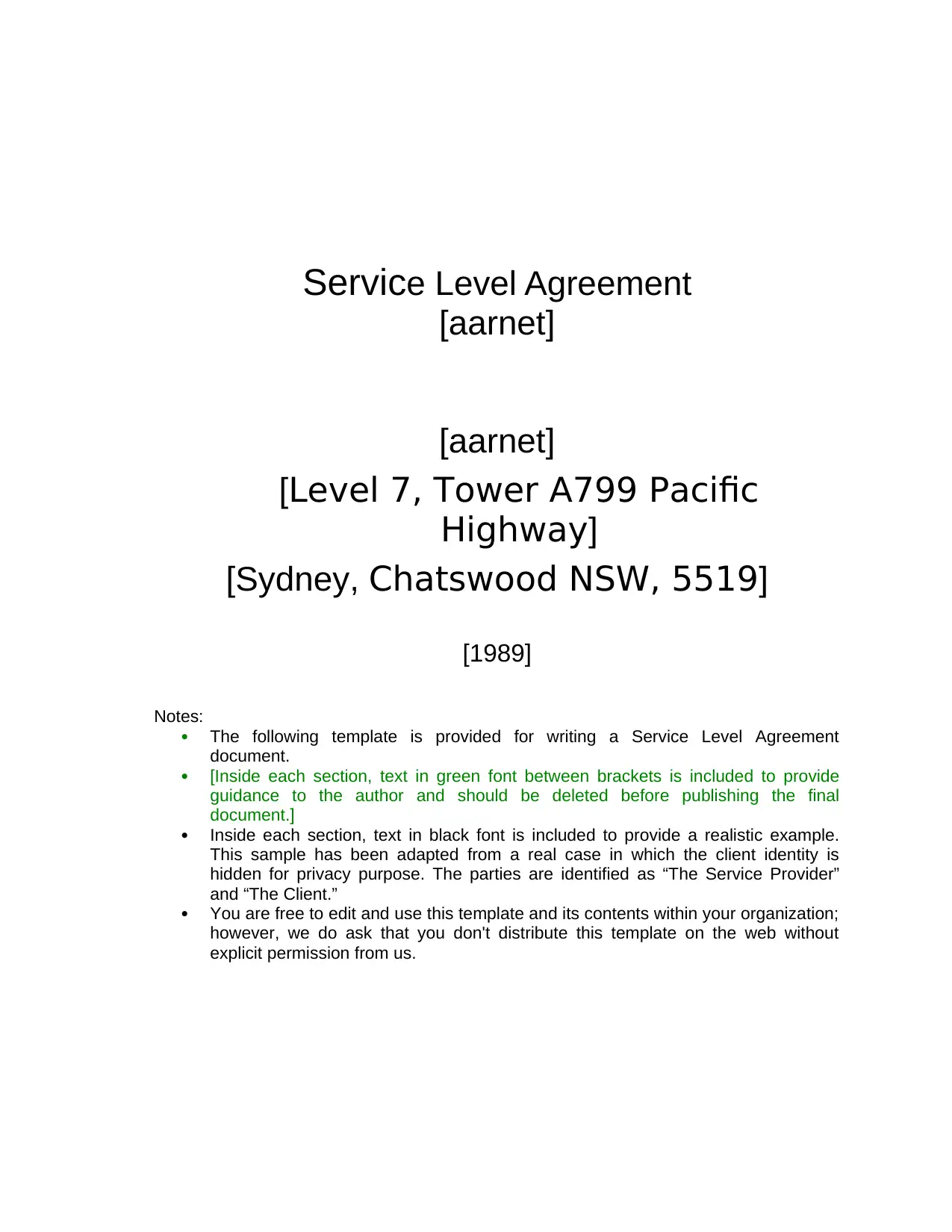
Service Level Agreement
[aarnet]
[aarnet]
[Level 7, Tower A799 Pacific
Highway]
[Sydney, Chatswood NSW, 5519]
[1989]
Notes:
The following template is provided for writing a Service Level Agreement
document.
[Inside each section, text in green font between brackets is included to provide
guidance to the author and should be deleted before publishing the final
document.]
Inside each section, text in black font is included to provide a realistic example.
This sample has been adapted from a real case in which the client identity is
hidden for privacy purpose. The parties are identified as “The Service Provider”
and “The Client.”
You are free to edit and use this template and its contents within your organization;
however, we do ask that you don't distribute this template on the web without
explicit permission from us.
[aarnet]
[aarnet]
[Level 7, Tower A799 Pacific
Highway]
[Sydney, Chatswood NSW, 5519]
[1989]
Notes:
The following template is provided for writing a Service Level Agreement
document.
[Inside each section, text in green font between brackets is included to provide
guidance to the author and should be deleted before publishing the final
document.]
Inside each section, text in black font is included to provide a realistic example.
This sample has been adapted from a real case in which the client identity is
hidden for privacy purpose. The parties are identified as “The Service Provider”
and “The Client.”
You are free to edit and use this template and its contents within your organization;
however, we do ask that you don't distribute this template on the web without
explicit permission from us.
Secure Best Marks with AI Grader
Need help grading? Try our AI Grader for instant feedback on your assignments.
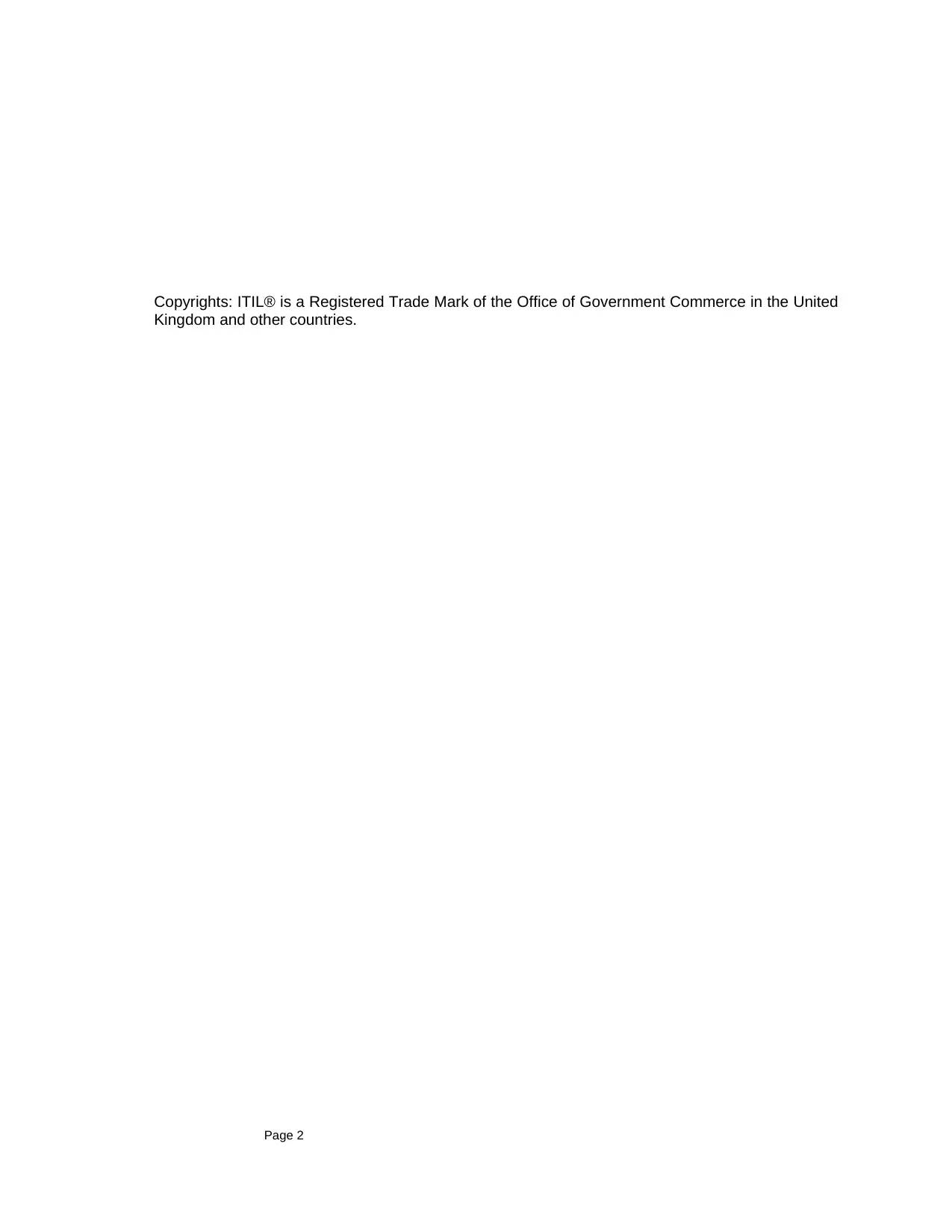
Copyrights: ITIL® is a Registered Trade Mark of the Office of Government Commerce in the United
Kingdom and other countries.
Page 2
Kingdom and other countries.
Page 2
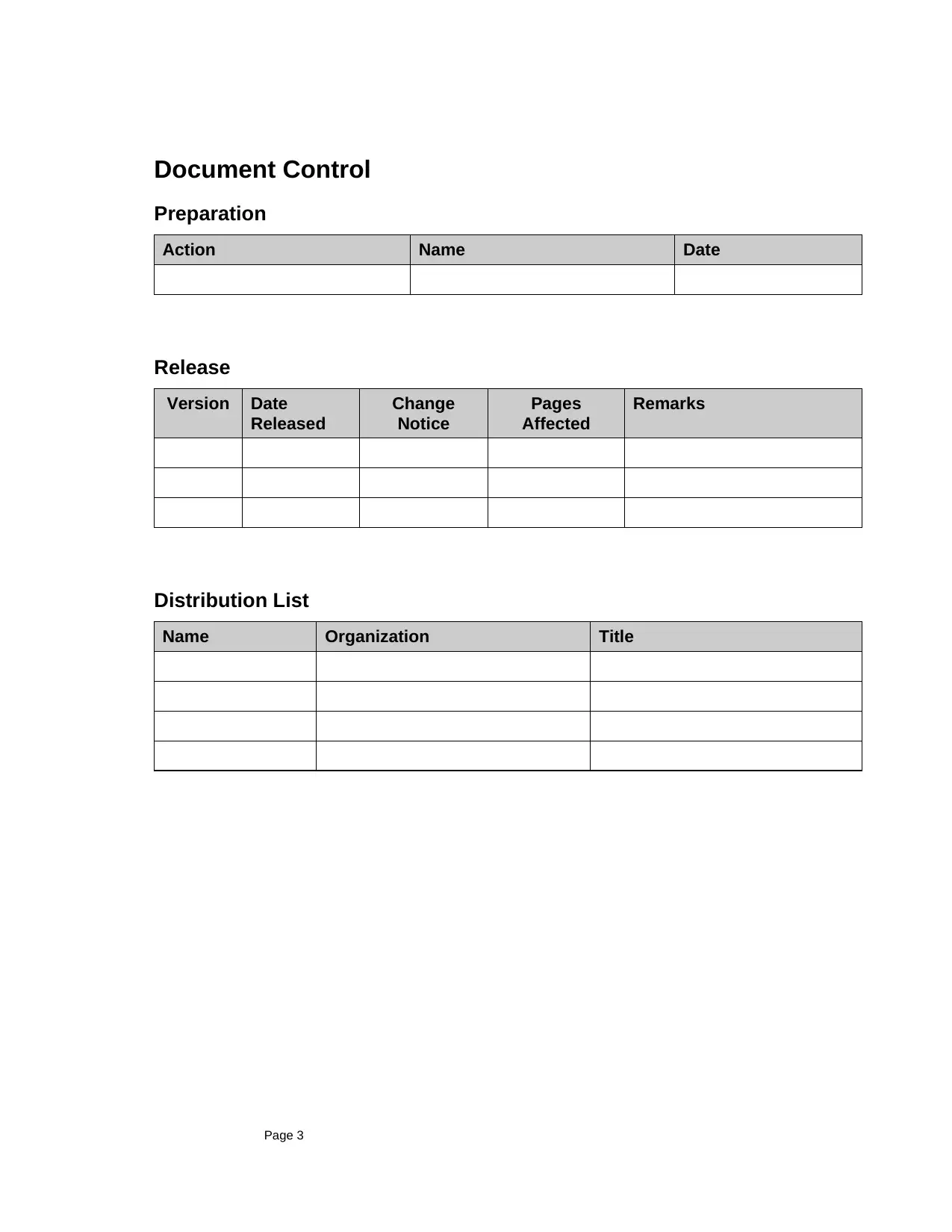
Document Control
Preparation
Action Name Date
Release
Version Date
Released
Change
Notice
Pages
Affected
Remarks
Distribution List
Name Organization Title
Page 3
Preparation
Action Name Date
Release
Version Date
Released
Change
Notice
Pages
Affected
Remarks
Distribution List
Name Organization Title
Page 3
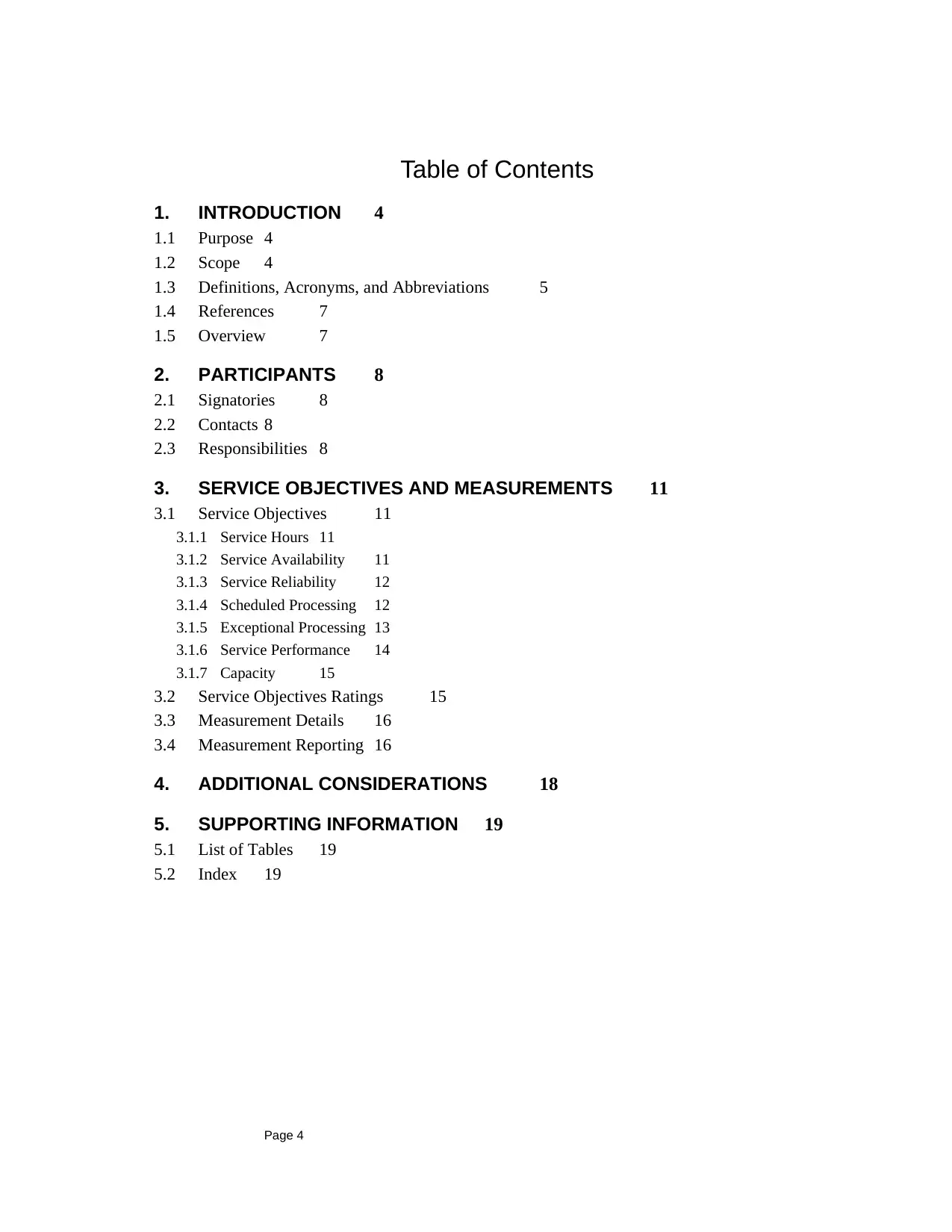
Table of Contents
1. INTRODUCTION 4
1.1 Purpose 4
1.2 Scope 4
1.3 Definitions, Acronyms, and Abbreviations 5
1.4 References 7
1.5 Overview 7
2. PARTICIPANTS 8
2.1 Signatories 8
2.2 Contacts 8
2.3 Responsibilities 8
3. SERVICE OBJECTIVES AND MEASUREMENTS 11
3.1 Service Objectives 11
3.1.1 Service Hours 11
3.1.2 Service Availability 11
3.1.3 Service Reliability 12
3.1.4 Scheduled Processing 12
3.1.5 Exceptional Processing 13
3.1.6 Service Performance 14
3.1.7 Capacity 15
3.2 Service Objectives Ratings 15
3.3 Measurement Details 16
3.4 Measurement Reporting 16
4. ADDITIONAL CONSIDERATIONS 18
5. SUPPORTING INFORMATION 19
5.1 List of Tables 19
5.2 Index 19
Page 4
1. INTRODUCTION 4
1.1 Purpose 4
1.2 Scope 4
1.3 Definitions, Acronyms, and Abbreviations 5
1.4 References 7
1.5 Overview 7
2. PARTICIPANTS 8
2.1 Signatories 8
2.2 Contacts 8
2.3 Responsibilities 8
3. SERVICE OBJECTIVES AND MEASUREMENTS 11
3.1 Service Objectives 11
3.1.1 Service Hours 11
3.1.2 Service Availability 11
3.1.3 Service Reliability 12
3.1.4 Scheduled Processing 12
3.1.5 Exceptional Processing 13
3.1.6 Service Performance 14
3.1.7 Capacity 15
3.2 Service Objectives Ratings 15
3.3 Measurement Details 16
3.4 Measurement Reporting 16
4. ADDITIONAL CONSIDERATIONS 18
5. SUPPORTING INFORMATION 19
5.1 List of Tables 19
5.2 Index 19
Page 4
Secure Best Marks with AI Grader
Need help grading? Try our AI Grader for instant feedback on your assignments.
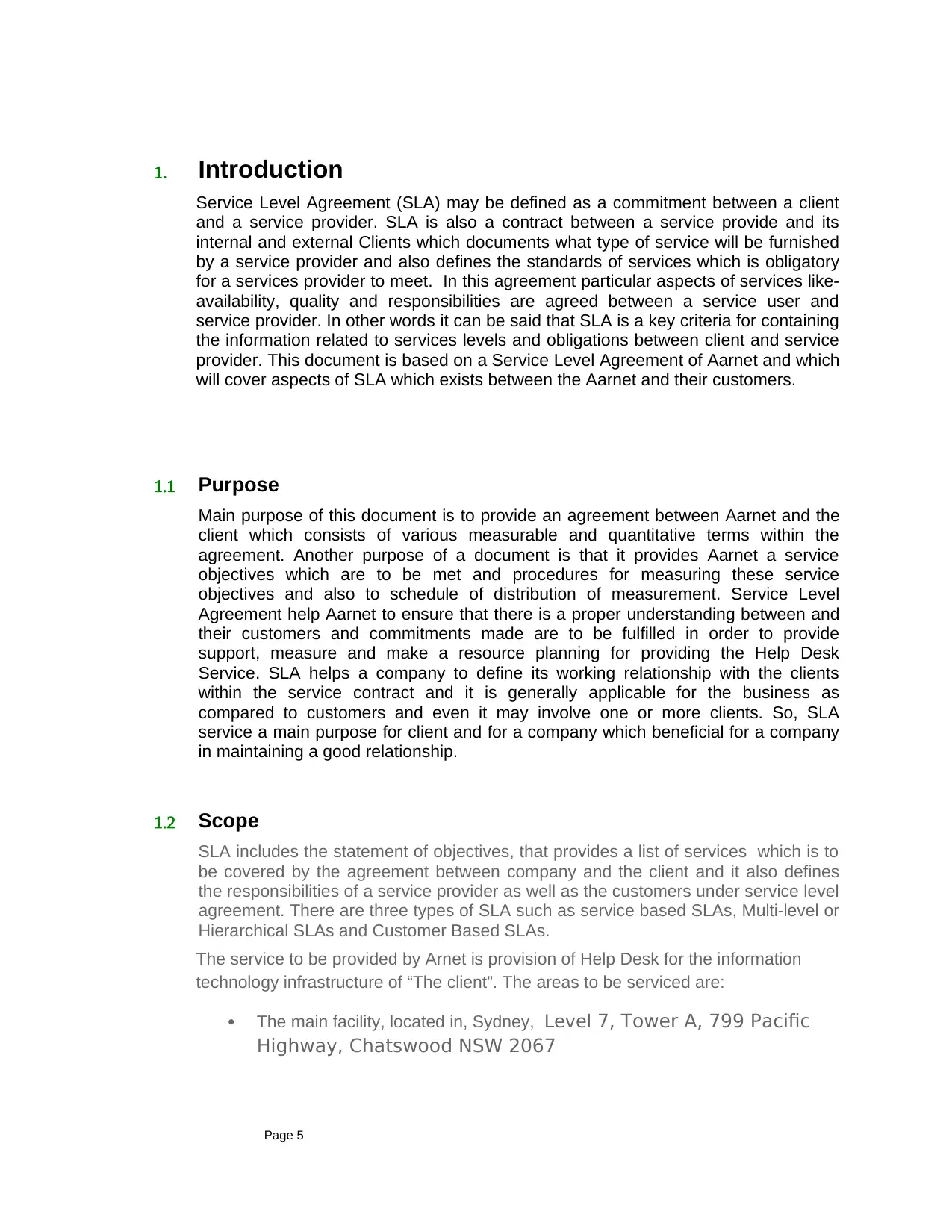
1. Introduction
Service Level Agreement (SLA) may be defined as a commitment between a client
and a service provider. SLA is also a contract between a service provide and its
internal and external Clients which documents what type of service will be furnished
by a service provider and also defines the standards of services which is obligatory
for a services provider to meet. In this agreement particular aspects of services like-
availability, quality and responsibilities are agreed between a service user and
service provider. In other words it can be said that SLA is a key criteria for containing
the information related to services levels and obligations between client and service
provider. This document is based on a Service Level Agreement of Aarnet and which
will cover aspects of SLA which exists between the Aarnet and their customers.
1.1 Purpose
Main purpose of this document is to provide an agreement between Aarnet and the
client which consists of various measurable and quantitative terms within the
agreement. Another purpose of a document is that it provides Aarnet a service
objectives which are to be met and procedures for measuring these service
objectives and also to schedule of distribution of measurement. Service Level
Agreement help Aarnet to ensure that there is a proper understanding between and
their customers and commitments made are to be fulfilled in order to provide
support, measure and make a resource planning for providing the Help Desk
Service. SLA helps a company to define its working relationship with the clients
within the service contract and it is generally applicable for the business as
compared to customers and even it may involve one or more clients. So, SLA
service a main purpose for client and for a company which beneficial for a company
in maintaining a good relationship.
1.2 Scope
SLA includes the statement of objectives, that provides a list of services which is to
be covered by the agreement between company and the client and it also defines
the responsibilities of a service provider as well as the customers under service level
agreement. There are three types of SLA such as service based SLAs, Multi-level or
Hierarchical SLAs and Customer Based SLAs.
The service to be provided by Arnet is provision of Help Desk for the information
technology infrastructure of “The client”. The areas to be serviced are:
The main facility, located in, Sydney, Level 7, Tower A, 799 Pacific
Highway, Chatswood NSW 2067
Page 5
Service Level Agreement (SLA) may be defined as a commitment between a client
and a service provider. SLA is also a contract between a service provide and its
internal and external Clients which documents what type of service will be furnished
by a service provider and also defines the standards of services which is obligatory
for a services provider to meet. In this agreement particular aspects of services like-
availability, quality and responsibilities are agreed between a service user and
service provider. In other words it can be said that SLA is a key criteria for containing
the information related to services levels and obligations between client and service
provider. This document is based on a Service Level Agreement of Aarnet and which
will cover aspects of SLA which exists between the Aarnet and their customers.
1.1 Purpose
Main purpose of this document is to provide an agreement between Aarnet and the
client which consists of various measurable and quantitative terms within the
agreement. Another purpose of a document is that it provides Aarnet a service
objectives which are to be met and procedures for measuring these service
objectives and also to schedule of distribution of measurement. Service Level
Agreement help Aarnet to ensure that there is a proper understanding between and
their customers and commitments made are to be fulfilled in order to provide
support, measure and make a resource planning for providing the Help Desk
Service. SLA helps a company to define its working relationship with the clients
within the service contract and it is generally applicable for the business as
compared to customers and even it may involve one or more clients. So, SLA
service a main purpose for client and for a company which beneficial for a company
in maintaining a good relationship.
1.2 Scope
SLA includes the statement of objectives, that provides a list of services which is to
be covered by the agreement between company and the client and it also defines
the responsibilities of a service provider as well as the customers under service level
agreement. There are three types of SLA such as service based SLAs, Multi-level or
Hierarchical SLAs and Customer Based SLAs.
The service to be provided by Arnet is provision of Help Desk for the information
technology infrastructure of “The client”. The areas to be serviced are:
The main facility, located in, Sydney, Level 7, Tower A, 799 Pacific
Highway, Chatswood NSW 2067
Page 5
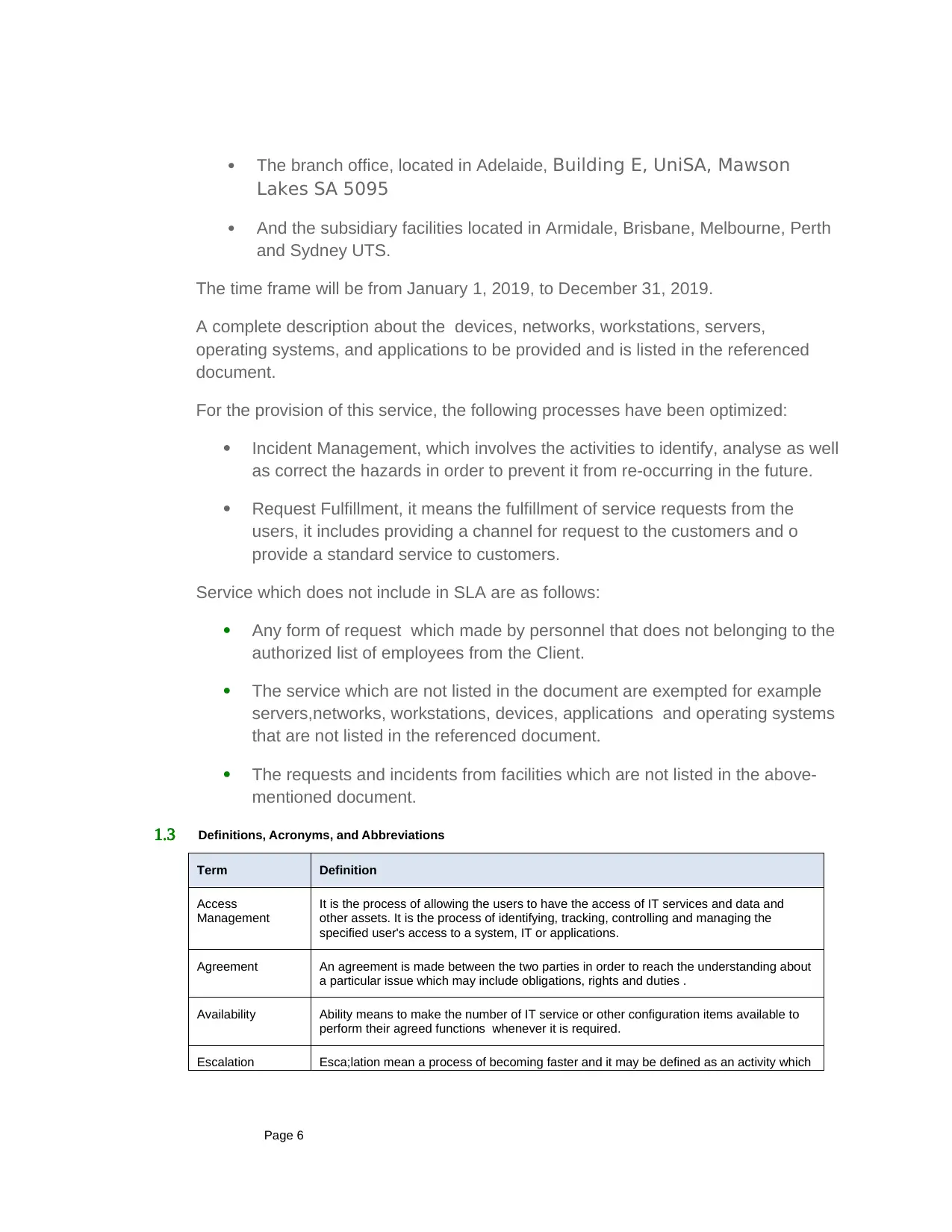
The branch office, located in Adelaide, Building E, UniSA, Mawson
Lakes SA 5095
And the subsidiary facilities located in Armidale, Brisbane, Melbourne, Perth
and Sydney UTS.
The time frame will be from January 1, 2019, to December 31, 2019.
A complete description about the devices, networks, workstations, servers,
operating systems, and applications to be provided and is listed in the referenced
document.
For the provision of this service, the following processes have been optimized:
Incident Management, which involves the activities to identify, analyse as well
as correct the hazards in order to prevent it from re-occurring in the future.
Request Fulfillment, it means the fulfillment of service requests from the
users, it includes providing a channel for request to the customers and o
provide a standard service to customers.
Service which does not include in SLA are as follows:
Any form of request which made by personnel that does not belonging to the
authorized list of employees from the Client.
The service which are not listed in the document are exempted for example
servers,networks, workstations, devices, applications and operating systems
that are not listed in the referenced document.
The requests and incidents from facilities which are not listed in the above-
mentioned document.
1.3 Definitions, Acronyms, and Abbreviations
Term Definition
Access
Management
It is the process of allowing the users to have the access of IT services and data and
other assets. It is the process of identifying, tracking, controlling and managing the
specified user's access to a system, IT or applications.
Agreement An agreement is made between the two parties in order to reach the understanding about
a particular issue which may include obligations, rights and duties .
Availability Ability means to make the number of IT service or other configuration items available to
perform their agreed functions whenever it is required.
Escalation Esca;lation mean a process of becoming faster and it may be defined as an activity which
Page 6
Lakes SA 5095
And the subsidiary facilities located in Armidale, Brisbane, Melbourne, Perth
and Sydney UTS.
The time frame will be from January 1, 2019, to December 31, 2019.
A complete description about the devices, networks, workstations, servers,
operating systems, and applications to be provided and is listed in the referenced
document.
For the provision of this service, the following processes have been optimized:
Incident Management, which involves the activities to identify, analyse as well
as correct the hazards in order to prevent it from re-occurring in the future.
Request Fulfillment, it means the fulfillment of service requests from the
users, it includes providing a channel for request to the customers and o
provide a standard service to customers.
Service which does not include in SLA are as follows:
Any form of request which made by personnel that does not belonging to the
authorized list of employees from the Client.
The service which are not listed in the document are exempted for example
servers,networks, workstations, devices, applications and operating systems
that are not listed in the referenced document.
The requests and incidents from facilities which are not listed in the above-
mentioned document.
1.3 Definitions, Acronyms, and Abbreviations
Term Definition
Access
Management
It is the process of allowing the users to have the access of IT services and data and
other assets. It is the process of identifying, tracking, controlling and managing the
specified user's access to a system, IT or applications.
Agreement An agreement is made between the two parties in order to reach the understanding about
a particular issue which may include obligations, rights and duties .
Availability Ability means to make the number of IT service or other configuration items available to
perform their agreed functions whenever it is required.
Escalation Esca;lation mean a process of becoming faster and it may be defined as an activity which
Page 6
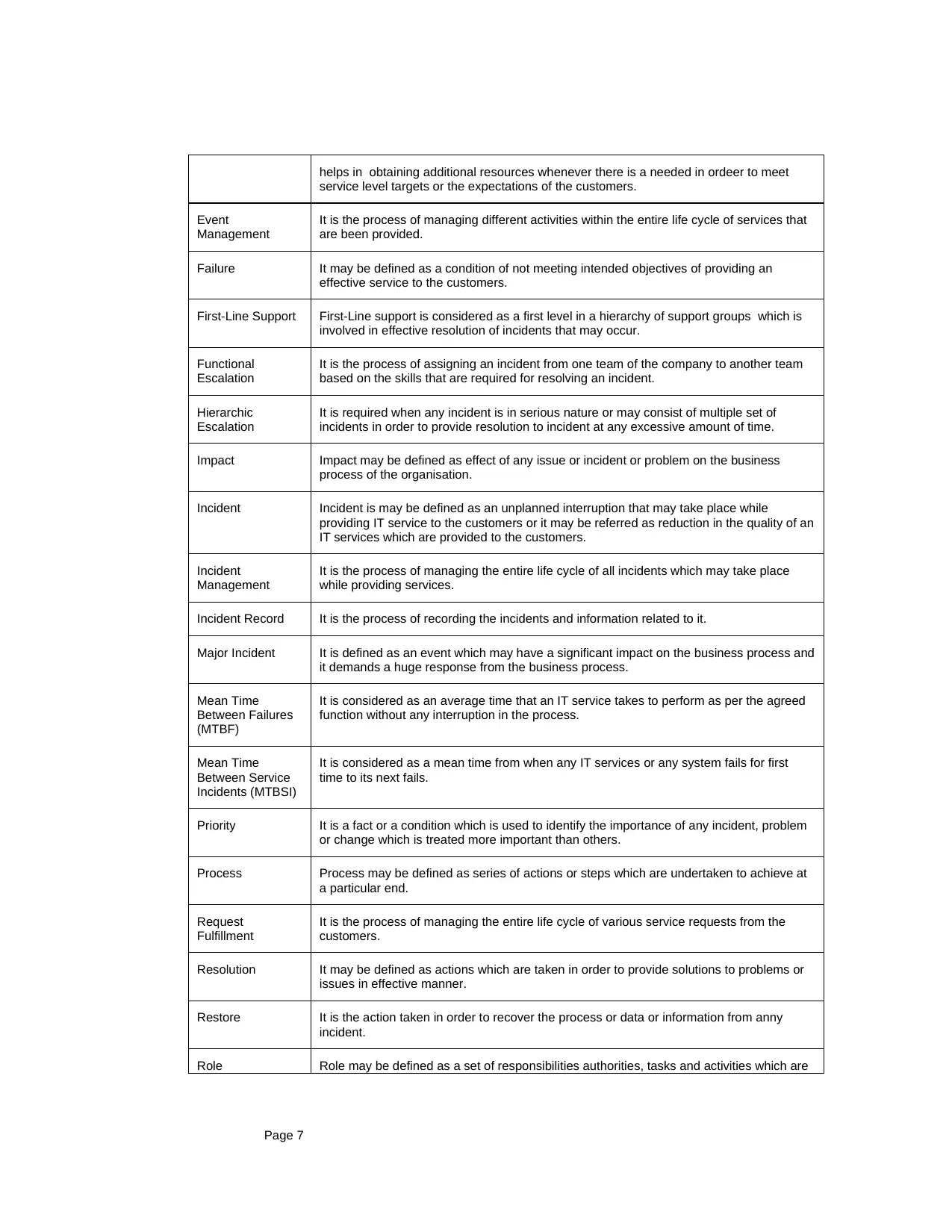
helps in obtaining additional resources whenever there is a needed in ordeer to meet
service level targets or the expectations of the customers.
Event
Management
It is the process of managing different activities within the entire life cycle of services that
are been provided.
Failure It may be defined as a condition of not meeting intended objectives of providing an
effective service to the customers.
First-Line Support First-Line support is considered as a first level in a hierarchy of support groups which is
involved in effective resolution of incidents that may occur.
Functional
Escalation
It is the process of assigning an incident from one team of the company to another team
based on the skills that are required for resolving an incident.
Hierarchic
Escalation
It is required when any incident is in serious nature or may consist of multiple set of
incidents in order to provide resolution to incident at any excessive amount of time.
Impact Impact may be defined as effect of any issue or incident or problem on the business
process of the organisation.
Incident Incident is may be defined as an unplanned interruption that may take place while
providing IT service to the customers or it may be referred as reduction in the quality of an
IT services which are provided to the customers.
Incident
Management
It is the process of managing the entire life cycle of all incidents which may take place
while providing services.
Incident Record It is the process of recording the incidents and information related to it.
Major Incident It is defined as an event which may have a significant impact on the business process and
it demands a huge response from the business process.
Mean Time
Between Failures
(MTBF)
It is considered as an average time that an IT service takes to perform as per the agreed
function without any interruption in the process.
Mean Time
Between Service
Incidents (MTBSI)
It is considered as a mean time from when any IT services or any system fails for first
time to its next fails.
Priority It is a fact or a condition which is used to identify the importance of any incident, problem
or change which is treated more important than others.
Process Process may be defined as series of actions or steps which are undertaken to achieve at
a particular end.
Request
Fulfillment
It is the process of managing the entire life cycle of various service requests from the
customers.
Resolution It may be defined as actions which are taken in order to provide solutions to problems or
issues in effective manner.
Restore It is the action taken in order to recover the process or data or information from anny
incident.
Role Role may be defined as a set of responsibilities authorities, tasks and activities which are
Page 7
service level targets or the expectations of the customers.
Event
Management
It is the process of managing different activities within the entire life cycle of services that
are been provided.
Failure It may be defined as a condition of not meeting intended objectives of providing an
effective service to the customers.
First-Line Support First-Line support is considered as a first level in a hierarchy of support groups which is
involved in effective resolution of incidents that may occur.
Functional
Escalation
It is the process of assigning an incident from one team of the company to another team
based on the skills that are required for resolving an incident.
Hierarchic
Escalation
It is required when any incident is in serious nature or may consist of multiple set of
incidents in order to provide resolution to incident at any excessive amount of time.
Impact Impact may be defined as effect of any issue or incident or problem on the business
process of the organisation.
Incident Incident is may be defined as an unplanned interruption that may take place while
providing IT service to the customers or it may be referred as reduction in the quality of an
IT services which are provided to the customers.
Incident
Management
It is the process of managing the entire life cycle of all incidents which may take place
while providing services.
Incident Record It is the process of recording the incidents and information related to it.
Major Incident It is defined as an event which may have a significant impact on the business process and
it demands a huge response from the business process.
Mean Time
Between Failures
(MTBF)
It is considered as an average time that an IT service takes to perform as per the agreed
function without any interruption in the process.
Mean Time
Between Service
Incidents (MTBSI)
It is considered as a mean time from when any IT services or any system fails for first
time to its next fails.
Priority It is a fact or a condition which is used to identify the importance of any incident, problem
or change which is treated more important than others.
Process Process may be defined as series of actions or steps which are undertaken to achieve at
a particular end.
Request
Fulfillment
It is the process of managing the entire life cycle of various service requests from the
customers.
Resolution It may be defined as actions which are taken in order to provide solutions to problems or
issues in effective manner.
Restore It is the action taken in order to recover the process or data or information from anny
incident.
Role Role may be defined as a set of responsibilities authorities, tasks and activities which are
Page 7
Paraphrase This Document
Need a fresh take? Get an instant paraphrase of this document with our AI Paraphraser
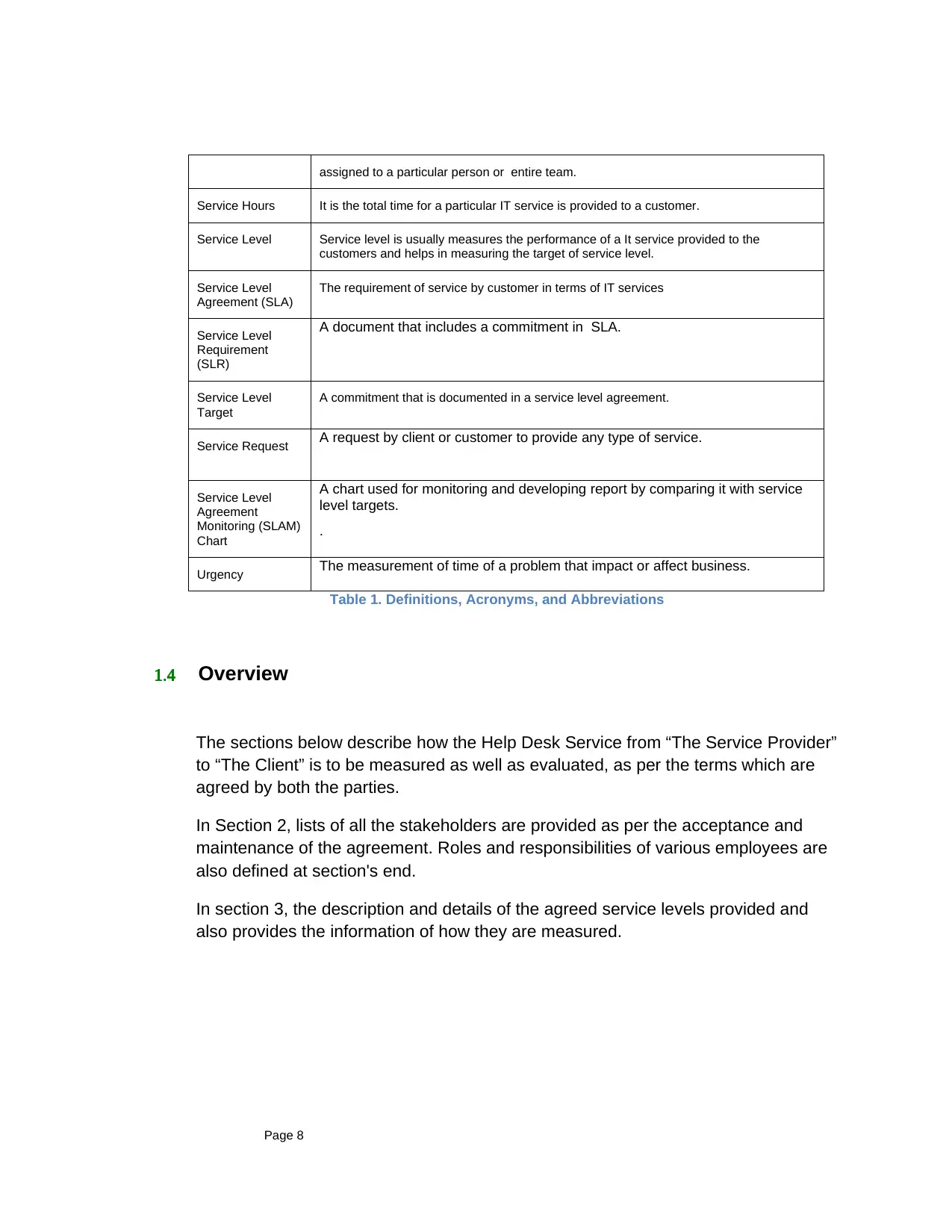
assigned to a particular person or entire team.
Service Hours It is the total time for a particular IT service is provided to a customer.
Service Level Service level is usually measures the performance of a It service provided to the
customers and helps in measuring the target of service level.
Service Level
Agreement (SLA)
The requirement of service by customer in terms of IT services
Service Level
Requirement
(SLR)
A document that includes a commitment in SLA.
Service Level
Target
A commitment that is documented in a service level agreement.
Service Request A request by client or customer to provide any type of service.
Service Level
Agreement
Monitoring (SLAM)
Chart
A chart used for monitoring and developing report by comparing it with service
level targets.
.
Urgency The measurement of time of a problem that impact or affect business.
Table 1. Definitions, Acronyms, and Abbreviations
1.4 Overview
The sections below describe how the Help Desk Service from “The Service Provider”
to “The Client” is to be measured as well as evaluated, as per the terms which are
agreed by both the parties.
In Section 2, lists of all the stakeholders are provided as per the acceptance and
maintenance of the agreement. Roles and responsibilities of various employees are
also defined at section's end.
In section 3, the description and details of the agreed service levels provided and
also provides the information of how they are measured.
Page 8
Service Hours It is the total time for a particular IT service is provided to a customer.
Service Level Service level is usually measures the performance of a It service provided to the
customers and helps in measuring the target of service level.
Service Level
Agreement (SLA)
The requirement of service by customer in terms of IT services
Service Level
Requirement
(SLR)
A document that includes a commitment in SLA.
Service Level
Target
A commitment that is documented in a service level agreement.
Service Request A request by client or customer to provide any type of service.
Service Level
Agreement
Monitoring (SLAM)
Chart
A chart used for monitoring and developing report by comparing it with service
level targets.
.
Urgency The measurement of time of a problem that impact or affect business.
Table 1. Definitions, Acronyms, and Abbreviations
1.4 Overview
The sections below describe how the Help Desk Service from “The Service Provider”
to “The Client” is to be measured as well as evaluated, as per the terms which are
agreed by both the parties.
In Section 2, lists of all the stakeholders are provided as per the acceptance and
maintenance of the agreement. Roles and responsibilities of various employees are
also defined at section's end.
In section 3, the description and details of the agreed service levels provided and
also provides the information of how they are measured.
Page 8
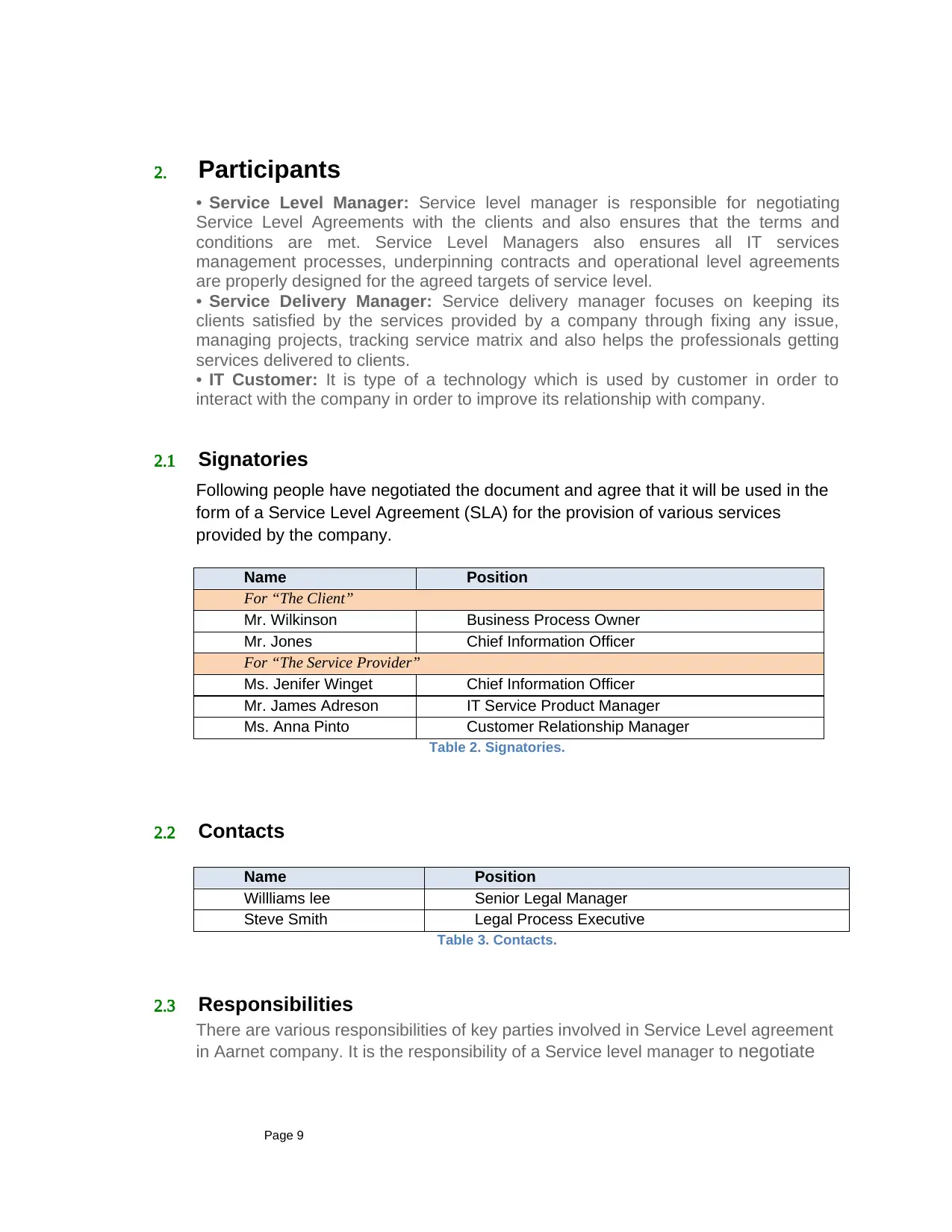
2. Participants
• Service Level Manager: Service level manager is responsible for negotiating
Service Level Agreements with the clients and also ensures that the terms and
conditions are met. Service Level Managers also ensures all IT services
management processes, underpinning contracts and operational level agreements
are properly designed for the agreed targets of service level.
• Service Delivery Manager: Service delivery manager focuses on keeping its
clients satisfied by the services provided by a company through fixing any issue,
managing projects, tracking service matrix and also helps the professionals getting
services delivered to clients.
• IT Customer: It is type of a technology which is used by customer in order to
interact with the company in order to improve its relationship with company.
2.1 Signatories
Following people have negotiated the document and agree that it will be used in the
form of a Service Level Agreement (SLA) for the provision of various services
provided by the company.
Name Position
For “The Client”
Mr. Wilkinson Business Process Owner
Mr. Jones Chief Information Officer
For “The Service Provider”
Ms. Jenifer Winget Chief Information Officer
Mr. James Adreson IT Service Product Manager
Ms. Anna Pinto Customer Relationship Manager
Table 2. Signatories.
2.2 Contacts
Name Position
Willliams lee Senior Legal Manager
Steve Smith Legal Process Executive
Table 3. Contacts.
2.3 Responsibilities
There are various responsibilities of key parties involved in Service Level agreement
in Aarnet company. It is the responsibility of a Service level manager to negotiate
Page 9
• Service Level Manager: Service level manager is responsible for negotiating
Service Level Agreements with the clients and also ensures that the terms and
conditions are met. Service Level Managers also ensures all IT services
management processes, underpinning contracts and operational level agreements
are properly designed for the agreed targets of service level.
• Service Delivery Manager: Service delivery manager focuses on keeping its
clients satisfied by the services provided by a company through fixing any issue,
managing projects, tracking service matrix and also helps the professionals getting
services delivered to clients.
• IT Customer: It is type of a technology which is used by customer in order to
interact with the company in order to improve its relationship with company.
2.1 Signatories
Following people have negotiated the document and agree that it will be used in the
form of a Service Level Agreement (SLA) for the provision of various services
provided by the company.
Name Position
For “The Client”
Mr. Wilkinson Business Process Owner
Mr. Jones Chief Information Officer
For “The Service Provider”
Ms. Jenifer Winget Chief Information Officer
Mr. James Adreson IT Service Product Manager
Ms. Anna Pinto Customer Relationship Manager
Table 2. Signatories.
2.2 Contacts
Name Position
Willliams lee Senior Legal Manager
Steve Smith Legal Process Executive
Table 3. Contacts.
2.3 Responsibilities
There are various responsibilities of key parties involved in Service Level agreement
in Aarnet company. It is the responsibility of a Service level manager to negotiate
Page 9
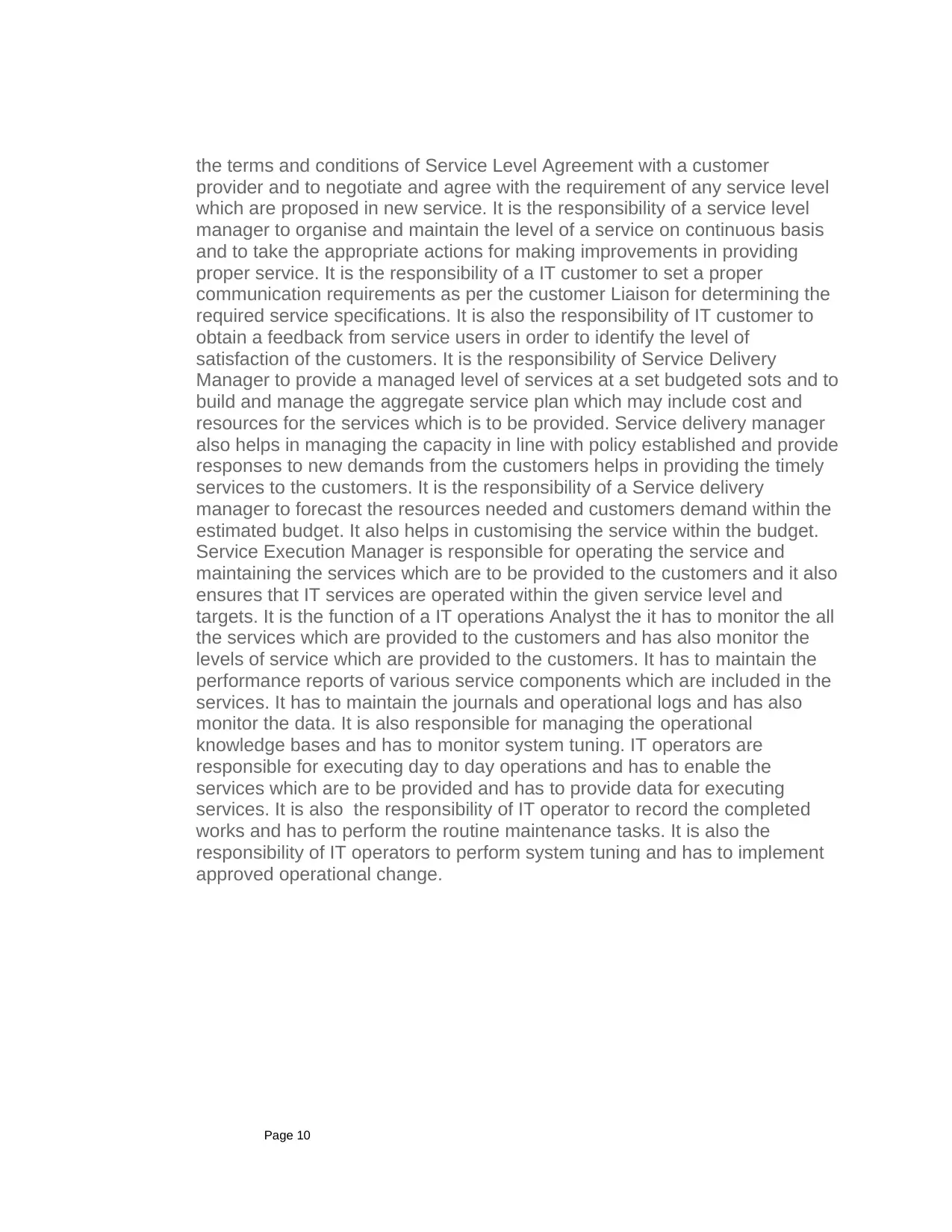
the terms and conditions of Service Level Agreement with a customer
provider and to negotiate and agree with the requirement of any service level
which are proposed in new service. It is the responsibility of a service level
manager to organise and maintain the level of a service on continuous basis
and to take the appropriate actions for making improvements in providing
proper service. It is the responsibility of a IT customer to set a proper
communication requirements as per the customer Liaison for determining the
required service specifications. It is also the responsibility of IT customer to
obtain a feedback from service users in order to identify the level of
satisfaction of the customers. It is the responsibility of Service Delivery
Manager to provide a managed level of services at a set budgeted sots and to
build and manage the aggregate service plan which may include cost and
resources for the services which is to be provided. Service delivery manager
also helps in managing the capacity in line with policy established and provide
responses to new demands from the customers helps in providing the timely
services to the customers. It is the responsibility of a Service delivery
manager to forecast the resources needed and customers demand within the
estimated budget. It also helps in customising the service within the budget.
Service Execution Manager is responsible for operating the service and
maintaining the services which are to be provided to the customers and it also
ensures that IT services are operated within the given service level and
targets. It is the function of a IT operations Analyst the it has to monitor the all
the services which are provided to the customers and has also monitor the
levels of service which are provided to the customers. It has to maintain the
performance reports of various service components which are included in the
services. It has to maintain the journals and operational logs and has also
monitor the data. It is also responsible for managing the operational
knowledge bases and has to monitor system tuning. IT operators are
responsible for executing day to day operations and has to enable the
services which are to be provided and has to provide data for executing
services. It is also the responsibility of IT operator to record the completed
works and has to perform the routine maintenance tasks. It is also the
responsibility of IT operators to perform system tuning and has to implement
approved operational change.
Page 10
provider and to negotiate and agree with the requirement of any service level
which are proposed in new service. It is the responsibility of a service level
manager to organise and maintain the level of a service on continuous basis
and to take the appropriate actions for making improvements in providing
proper service. It is the responsibility of a IT customer to set a proper
communication requirements as per the customer Liaison for determining the
required service specifications. It is also the responsibility of IT customer to
obtain a feedback from service users in order to identify the level of
satisfaction of the customers. It is the responsibility of Service Delivery
Manager to provide a managed level of services at a set budgeted sots and to
build and manage the aggregate service plan which may include cost and
resources for the services which is to be provided. Service delivery manager
also helps in managing the capacity in line with policy established and provide
responses to new demands from the customers helps in providing the timely
services to the customers. It is the responsibility of a Service delivery
manager to forecast the resources needed and customers demand within the
estimated budget. It also helps in customising the service within the budget.
Service Execution Manager is responsible for operating the service and
maintaining the services which are to be provided to the customers and it also
ensures that IT services are operated within the given service level and
targets. It is the function of a IT operations Analyst the it has to monitor the all
the services which are provided to the customers and has also monitor the
levels of service which are provided to the customers. It has to maintain the
performance reports of various service components which are included in the
services. It has to maintain the journals and operational logs and has also
monitor the data. It is also responsible for managing the operational
knowledge bases and has to monitor system tuning. IT operators are
responsible for executing day to day operations and has to enable the
services which are to be provided and has to provide data for executing
services. It is also the responsibility of IT operator to record the completed
works and has to perform the routine maintenance tasks. It is also the
responsibility of IT operators to perform system tuning and has to implement
approved operational change.
Page 10
Secure Best Marks with AI Grader
Need help grading? Try our AI Grader for instant feedback on your assignments.
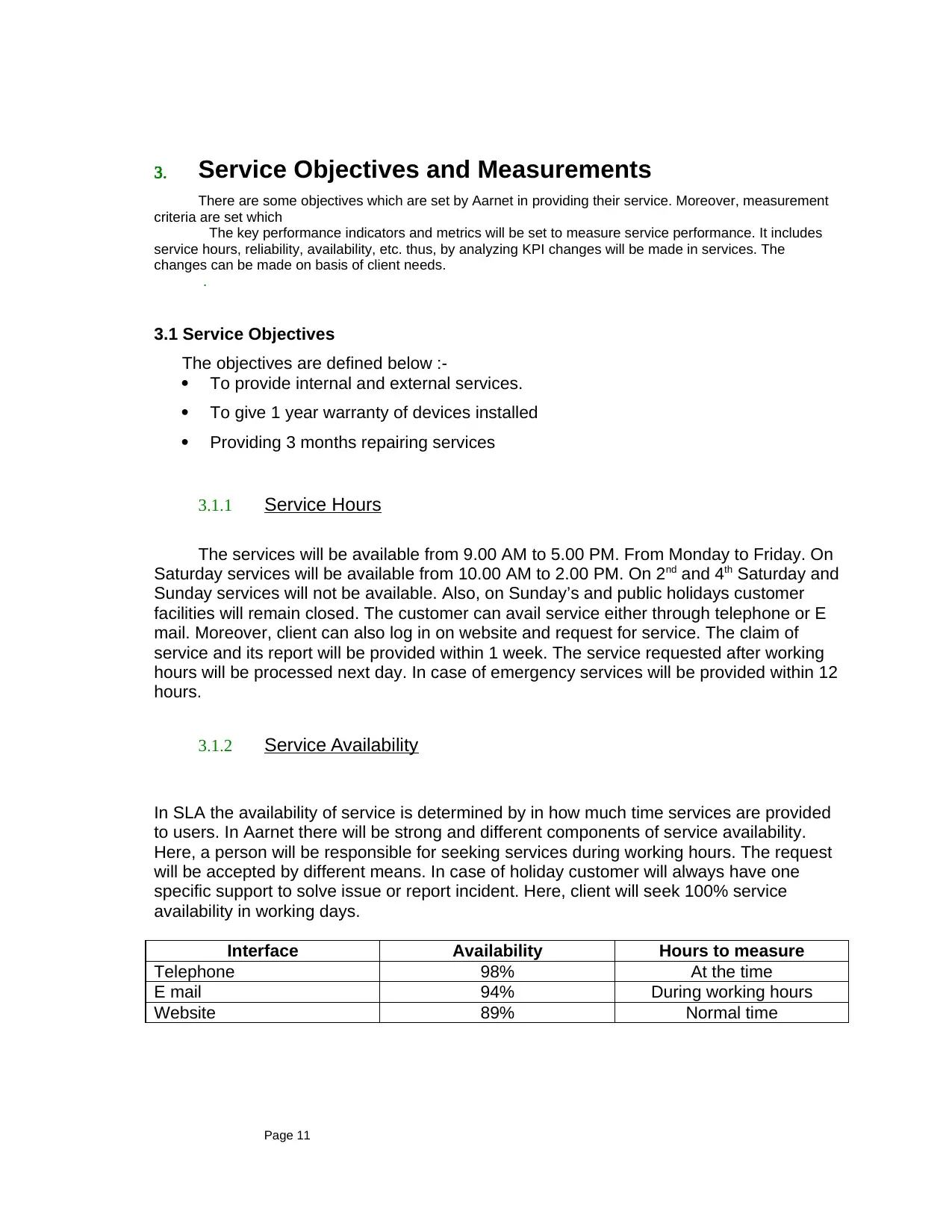
3. Service Objectives and Measurements
There are some objectives which are set by Aarnet in providing their service. Moreover, measurement
criteria are set which
The key performance indicators and metrics will be set to measure service performance. It includes
service hours, reliability, availability, etc. thus, by analyzing KPI changes will be made in services. The
changes can be made on basis of client needs.
.
3.1 Service Objectives
The objectives are defined below :-
To provide internal and external services.
To give 1 year warranty of devices installed
Providing 3 months repairing services
3.1.1 Service Hours
The services will be available from 9.00 AM to 5.00 PM. From Monday to Friday. On
Saturday services will be available from 10.00 AM to 2.00 PM. On 2nd and 4th Saturday and
Sunday services will not be available. Also, on Sunday’s and public holidays customer
facilities will remain closed. The customer can avail service either through telephone or E
mail. Moreover, client can also log in on website and request for service. The claim of
service and its report will be provided within 1 week. The service requested after working
hours will be processed next day. In case of emergency services will be provided within 12
hours.
3.1.2 Service Availability
In SLA the availability of service is determined by in how much time services are provided
to users. In Aarnet there will be strong and different components of service availability.
Here, a person will be responsible for seeking services during working hours. The request
will be accepted by different means. In case of holiday customer will always have one
specific support to solve issue or report incident. Here, client will seek 100% service
availability in working days.
Interface Availability Hours to measure
Telephone 98% At the time
E mail 94% During working hours
Website 89% Normal time
Page 11
There are some objectives which are set by Aarnet in providing their service. Moreover, measurement
criteria are set which
The key performance indicators and metrics will be set to measure service performance. It includes
service hours, reliability, availability, etc. thus, by analyzing KPI changes will be made in services. The
changes can be made on basis of client needs.
.
3.1 Service Objectives
The objectives are defined below :-
To provide internal and external services.
To give 1 year warranty of devices installed
Providing 3 months repairing services
3.1.1 Service Hours
The services will be available from 9.00 AM to 5.00 PM. From Monday to Friday. On
Saturday services will be available from 10.00 AM to 2.00 PM. On 2nd and 4th Saturday and
Sunday services will not be available. Also, on Sunday’s and public holidays customer
facilities will remain closed. The customer can avail service either through telephone or E
mail. Moreover, client can also log in on website and request for service. The claim of
service and its report will be provided within 1 week. The service requested after working
hours will be processed next day. In case of emergency services will be provided within 12
hours.
3.1.2 Service Availability
In SLA the availability of service is determined by in how much time services are provided
to users. In Aarnet there will be strong and different components of service availability.
Here, a person will be responsible for seeking services during working hours. The request
will be accepted by different means. In case of holiday customer will always have one
specific support to solve issue or report incident. Here, client will seek 100% service
availability in working days.
Interface Availability Hours to measure
Telephone 98% At the time
E mail 94% During working hours
Website 89% Normal time
Page 11
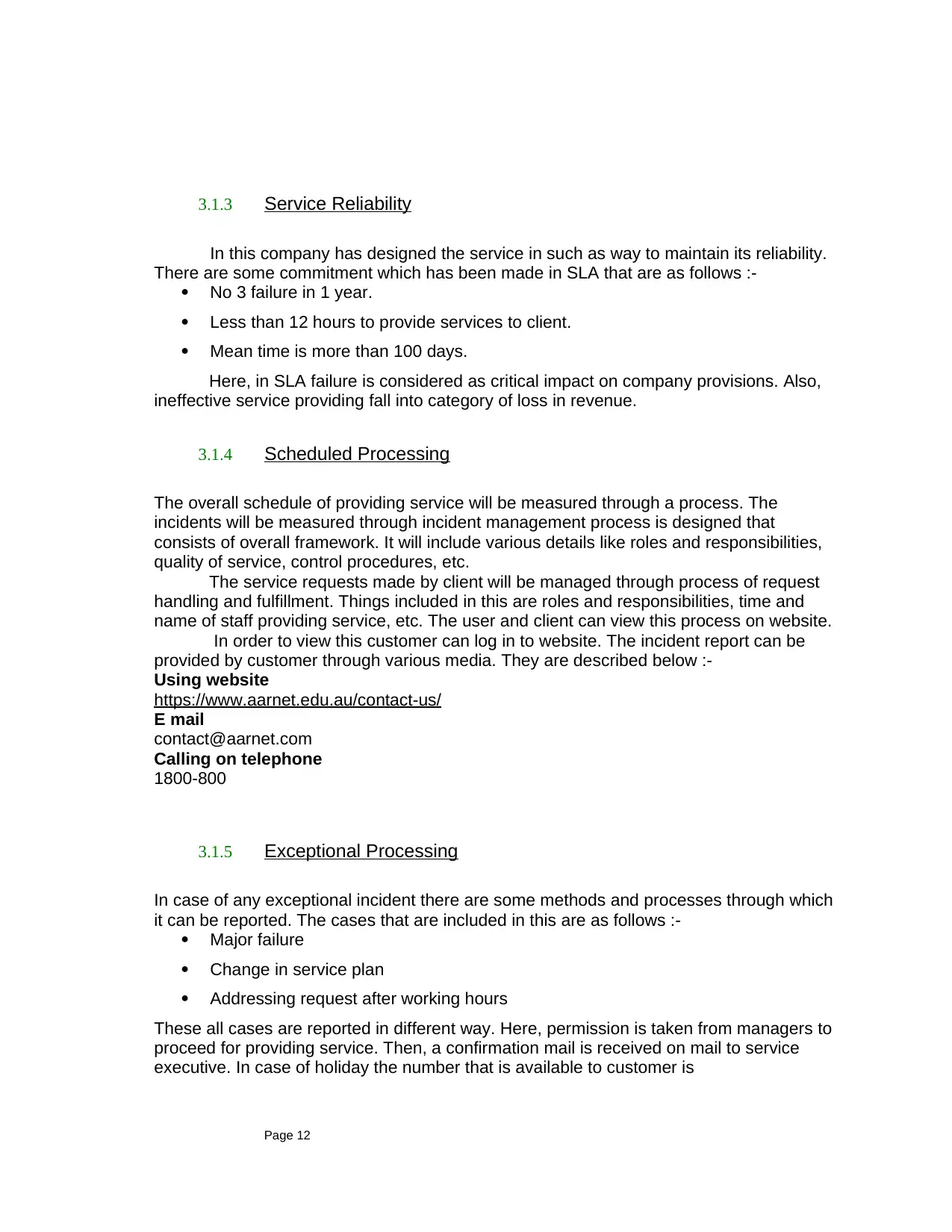
3.1.3 Service Reliability
In this company has designed the service in such as way to maintain its reliability.
There are some commitment which has been made in SLA that are as follows :-
No 3 failure in 1 year.
Less than 12 hours to provide services to client.
Mean time is more than 100 days.
Here, in SLA failure is considered as critical impact on company provisions. Also,
ineffective service providing fall into category of loss in revenue.
3.1.4 Scheduled Processing
The overall schedule of providing service will be measured through a process. The
incidents will be measured through incident management process is designed that
consists of overall framework. It will include various details like roles and responsibilities,
quality of service, control procedures, etc.
The service requests made by client will be managed through process of request
handling and fulfillment. Things included in this are roles and responsibilities, time and
name of staff providing service, etc. The user and client can view this process on website.
In order to view this customer can log in to website. The incident report can be
provided by customer through various media. They are described below :-
Using website
https://www.aarnet.edu.au/contact-us/
E mail
contact@aarnet.com
Calling on telephone
1800-800
3.1.5 Exceptional Processing
In case of any exceptional incident there are some methods and processes through which
it can be reported. The cases that are included in this are as follows :-
Major failure
Change in service plan
Addressing request after working hours
These all cases are reported in different way. Here, permission is taken from managers to
proceed for providing service. Then, a confirmation mail is received on mail to service
executive. In case of holiday the number that is available to customer is
Page 12
In this company has designed the service in such as way to maintain its reliability.
There are some commitment which has been made in SLA that are as follows :-
No 3 failure in 1 year.
Less than 12 hours to provide services to client.
Mean time is more than 100 days.
Here, in SLA failure is considered as critical impact on company provisions. Also,
ineffective service providing fall into category of loss in revenue.
3.1.4 Scheduled Processing
The overall schedule of providing service will be measured through a process. The
incidents will be measured through incident management process is designed that
consists of overall framework. It will include various details like roles and responsibilities,
quality of service, control procedures, etc.
The service requests made by client will be managed through process of request
handling and fulfillment. Things included in this are roles and responsibilities, time and
name of staff providing service, etc. The user and client can view this process on website.
In order to view this customer can log in to website. The incident report can be
provided by customer through various media. They are described below :-
Using website
https://www.aarnet.edu.au/contact-us/
E mail
contact@aarnet.com
Calling on telephone
1800-800
3.1.5 Exceptional Processing
In case of any exceptional incident there are some methods and processes through which
it can be reported. The cases that are included in this are as follows :-
Major failure
Change in service plan
Addressing request after working hours
These all cases are reported in different way. Here, permission is taken from managers to
proceed for providing service. Then, a confirmation mail is received on mail to service
executive. In case of holiday the number that is available to customer is
Page 12
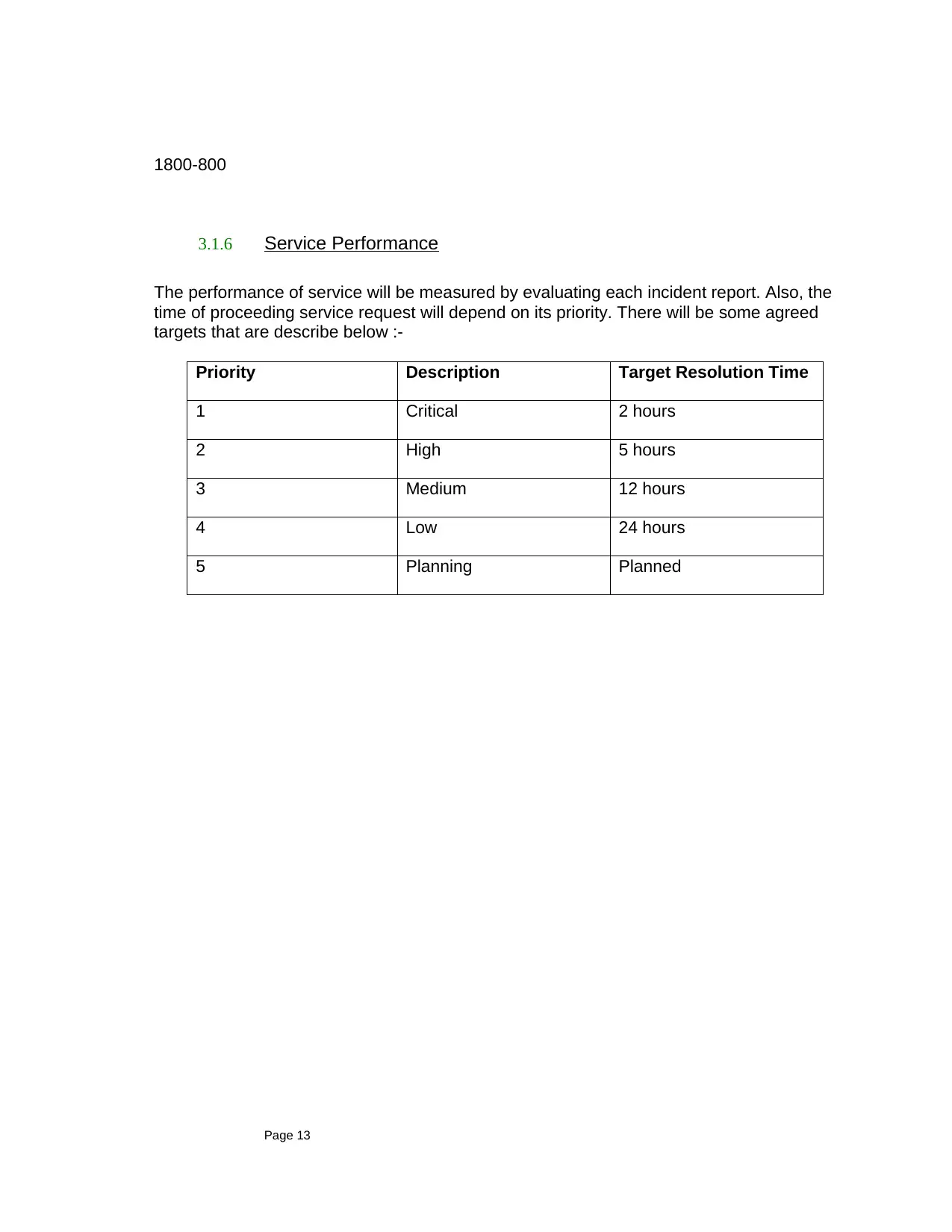
1800-800
3.1.6 Service Performance
The performance of service will be measured by evaluating each incident report. Also, the
time of proceeding service request will depend on its priority. There will be some agreed
targets that are describe below :-
Priority Description Target Resolution Time
1 Critical 2 hours
2 High 5 hours
3 Medium 12 hours
4 Low 24 hours
5 Planning Planned
Page 13
3.1.6 Service Performance
The performance of service will be measured by evaluating each incident report. Also, the
time of proceeding service request will depend on its priority. There will be some agreed
targets that are describe below :-
Priority Description Target Resolution Time
1 Critical 2 hours
2 High 5 hours
3 Medium 12 hours
4 Low 24 hours
5 Planning Planned
Page 13
Paraphrase This Document
Need a fresh take? Get an instant paraphrase of this document with our AI Paraphraser
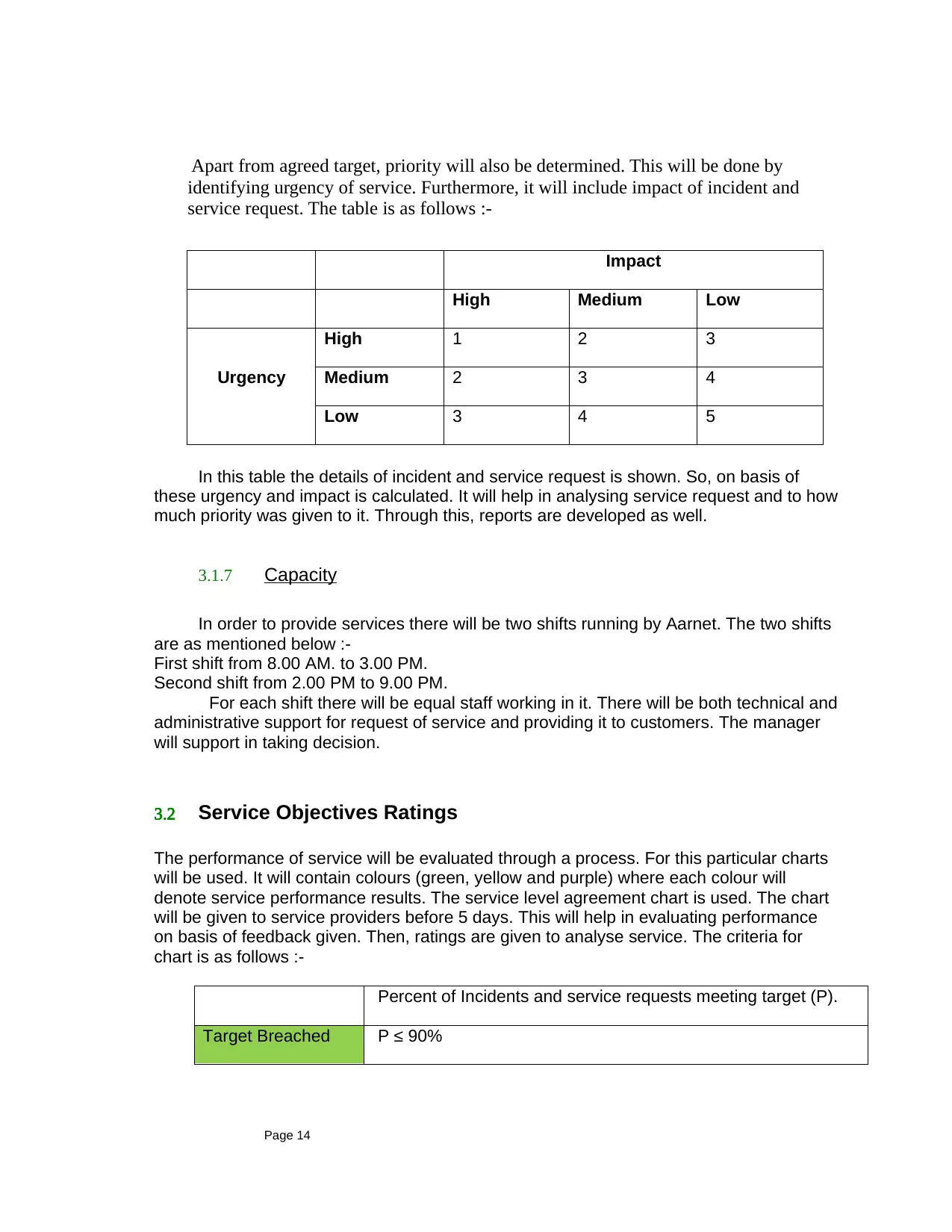
Apart from agreed target, priority will also be determined. This will be done by
identifying urgency of service. Furthermore, it will include impact of incident and
service request. The table is as follows :-
Impact
High Medium Low
Urgency
High 1 2 3
Medium 2 3 4
Low 3 4 5
In this table the details of incident and service request is shown. So, on basis of
these urgency and impact is calculated. It will help in analysing service request and to how
much priority was given to it. Through this, reports are developed as well.
3.1.7 Capacity
In order to provide services there will be two shifts running by Aarnet. The two shifts
are as mentioned below :-
First shift from 8.00 AM. to 3.00 PM.
Second shift from 2.00 PM to 9.00 PM.
For each shift there will be equal staff working in it. There will be both technical and
administrative support for request of service and providing it to customers. The manager
will support in taking decision.
3.2 Service Objectives Ratings
The performance of service will be evaluated through a process. For this particular charts
will be used. It will contain colours (green, yellow and purple) where each colour will
denote service performance results. The service level agreement chart is used. The chart
will be given to service providers before 5 days. This will help in evaluating performance
on basis of feedback given. Then, ratings are given to analyse service. The criteria for
chart is as follows :-
Percent of Incidents and service requests meeting target (P).
Target Breached P ≤ 90%
Page 14
identifying urgency of service. Furthermore, it will include impact of incident and
service request. The table is as follows :-
Impact
High Medium Low
Urgency
High 1 2 3
Medium 2 3 4
Low 3 4 5
In this table the details of incident and service request is shown. So, on basis of
these urgency and impact is calculated. It will help in analysing service request and to how
much priority was given to it. Through this, reports are developed as well.
3.1.7 Capacity
In order to provide services there will be two shifts running by Aarnet. The two shifts
are as mentioned below :-
First shift from 8.00 AM. to 3.00 PM.
Second shift from 2.00 PM to 9.00 PM.
For each shift there will be equal staff working in it. There will be both technical and
administrative support for request of service and providing it to customers. The manager
will support in taking decision.
3.2 Service Objectives Ratings
The performance of service will be evaluated through a process. For this particular charts
will be used. It will contain colours (green, yellow and purple) where each colour will
denote service performance results. The service level agreement chart is used. The chart
will be given to service providers before 5 days. This will help in evaluating performance
on basis of feedback given. Then, ratings are given to analyse service. The criteria for
chart is as follows :-
Percent of Incidents and service requests meeting target (P).
Target Breached P ≤ 90%
Page 14
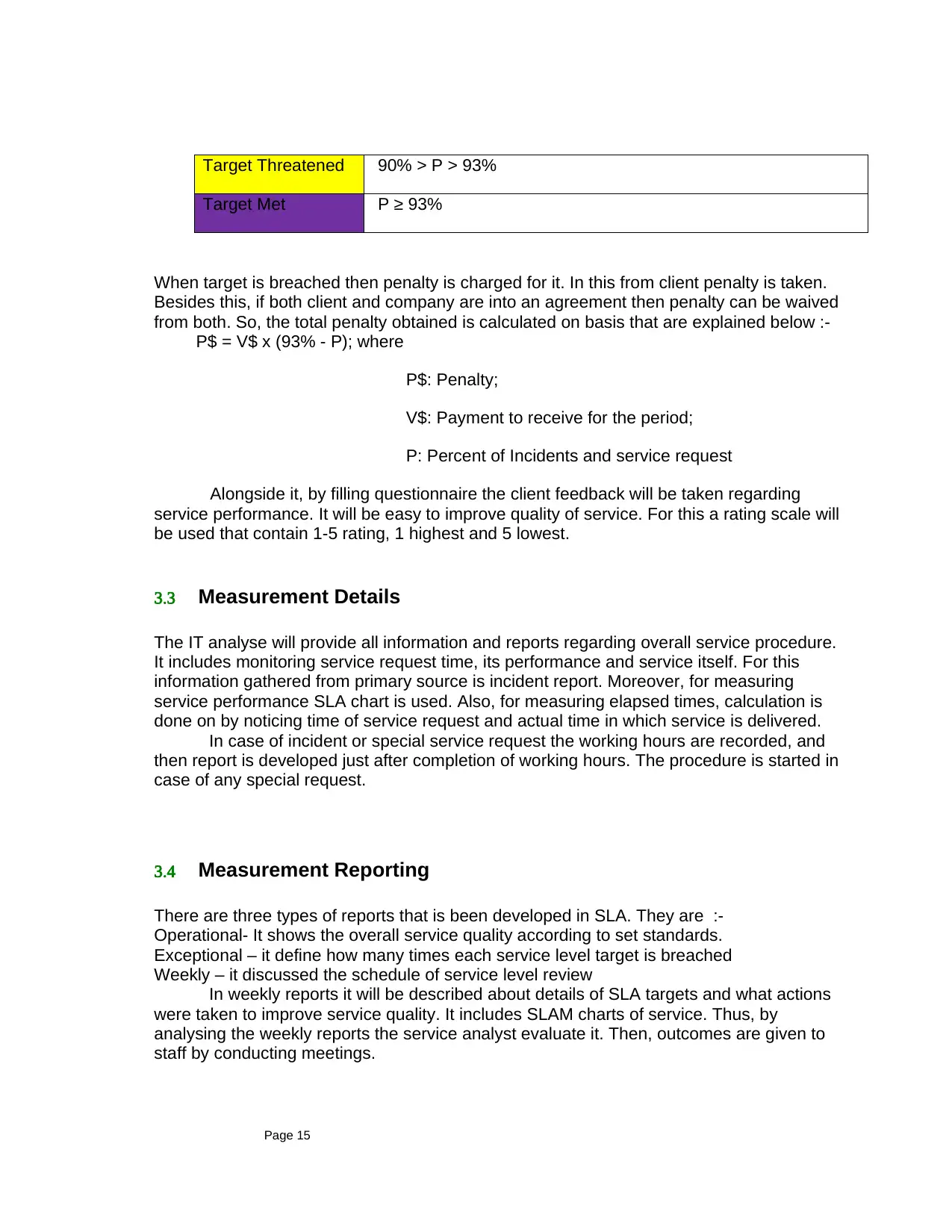
Target Threatened 90% > P > 93%
Target Met P ≥ 93%
When target is breached then penalty is charged for it. In this from client penalty is taken.
Besides this, if both client and company are into an agreement then penalty can be waived
from both. So, the total penalty obtained is calculated on basis that are explained below :-
P$ = V$ x (93% - P); where
P$: Penalty;
V$: Payment to receive for the period;
P: Percent of Incidents and service request
Alongside it, by filling questionnaire the client feedback will be taken regarding
service performance. It will be easy to improve quality of service. For this a rating scale will
be used that contain 1-5 rating, 1 highest and 5 lowest.
3.3 Measurement Details
The IT analyse will provide all information and reports regarding overall service procedure.
It includes monitoring service request time, its performance and service itself. For this
information gathered from primary source is incident report. Moreover, for measuring
service performance SLA chart is used. Also, for measuring elapsed times, calculation is
done on by noticing time of service request and actual time in which service is delivered.
In case of incident or special service request the working hours are recorded, and
then report is developed just after completion of working hours. The procedure is started in
case of any special request.
3.4 Measurement Reporting
There are three types of reports that is been developed in SLA. They are :-
Operational- It shows the overall service quality according to set standards.
Exceptional – it define how many times each service level target is breached
Weekly – it discussed the schedule of service level review
In weekly reports it will be described about details of SLA targets and what actions
were taken to improve service quality. It includes SLAM charts of service. Thus, by
analysing the weekly reports the service analyst evaluate it. Then, outcomes are given to
staff by conducting meetings.
Page 15
Target Met P ≥ 93%
When target is breached then penalty is charged for it. In this from client penalty is taken.
Besides this, if both client and company are into an agreement then penalty can be waived
from both. So, the total penalty obtained is calculated on basis that are explained below :-
P$ = V$ x (93% - P); where
P$: Penalty;
V$: Payment to receive for the period;
P: Percent of Incidents and service request
Alongside it, by filling questionnaire the client feedback will be taken regarding
service performance. It will be easy to improve quality of service. For this a rating scale will
be used that contain 1-5 rating, 1 highest and 5 lowest.
3.3 Measurement Details
The IT analyse will provide all information and reports regarding overall service procedure.
It includes monitoring service request time, its performance and service itself. For this
information gathered from primary source is incident report. Moreover, for measuring
service performance SLA chart is used. Also, for measuring elapsed times, calculation is
done on by noticing time of service request and actual time in which service is delivered.
In case of incident or special service request the working hours are recorded, and
then report is developed just after completion of working hours. The procedure is started in
case of any special request.
3.4 Measurement Reporting
There are three types of reports that is been developed in SLA. They are :-
Operational- It shows the overall service quality according to set standards.
Exceptional – it define how many times each service level target is breached
Weekly – it discussed the schedule of service level review
In weekly reports it will be described about details of SLA targets and what actions
were taken to improve service quality. It includes SLAM charts of service. Thus, by
analysing the weekly reports the service analyst evaluate it. Then, outcomes are given to
staff by conducting meetings.
Page 15

The reports will be developed every week and Aarnet manager will analyse it in
meetings. If one objective is not attained than measure will be taken to achieve it.
Page 16
meetings. If one objective is not attained than measure will be taken to achieve it.
Page 16
Secure Best Marks with AI Grader
Need help grading? Try our AI Grader for instant feedback on your assignments.
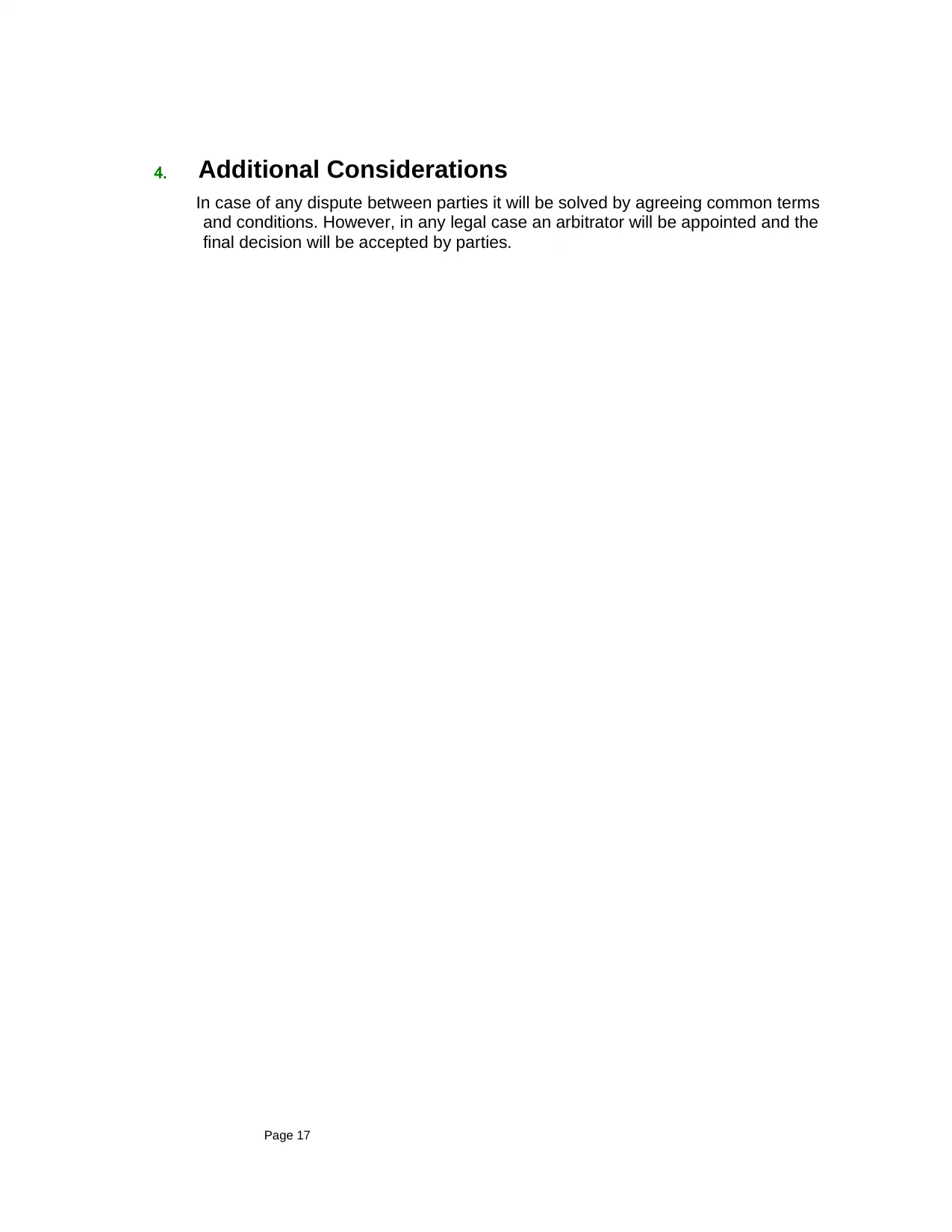
4. Additional Considerations
In case of any dispute between parties it will be solved by agreeing common terms
and conditions. However, in any legal case an arbitrator will be appointed and the
final decision will be accepted by parties.
Page 17
In case of any dispute between parties it will be solved by agreeing common terms
and conditions. However, in any legal case an arbitrator will be appointed and the
final decision will be accepted by parties.
Page 17
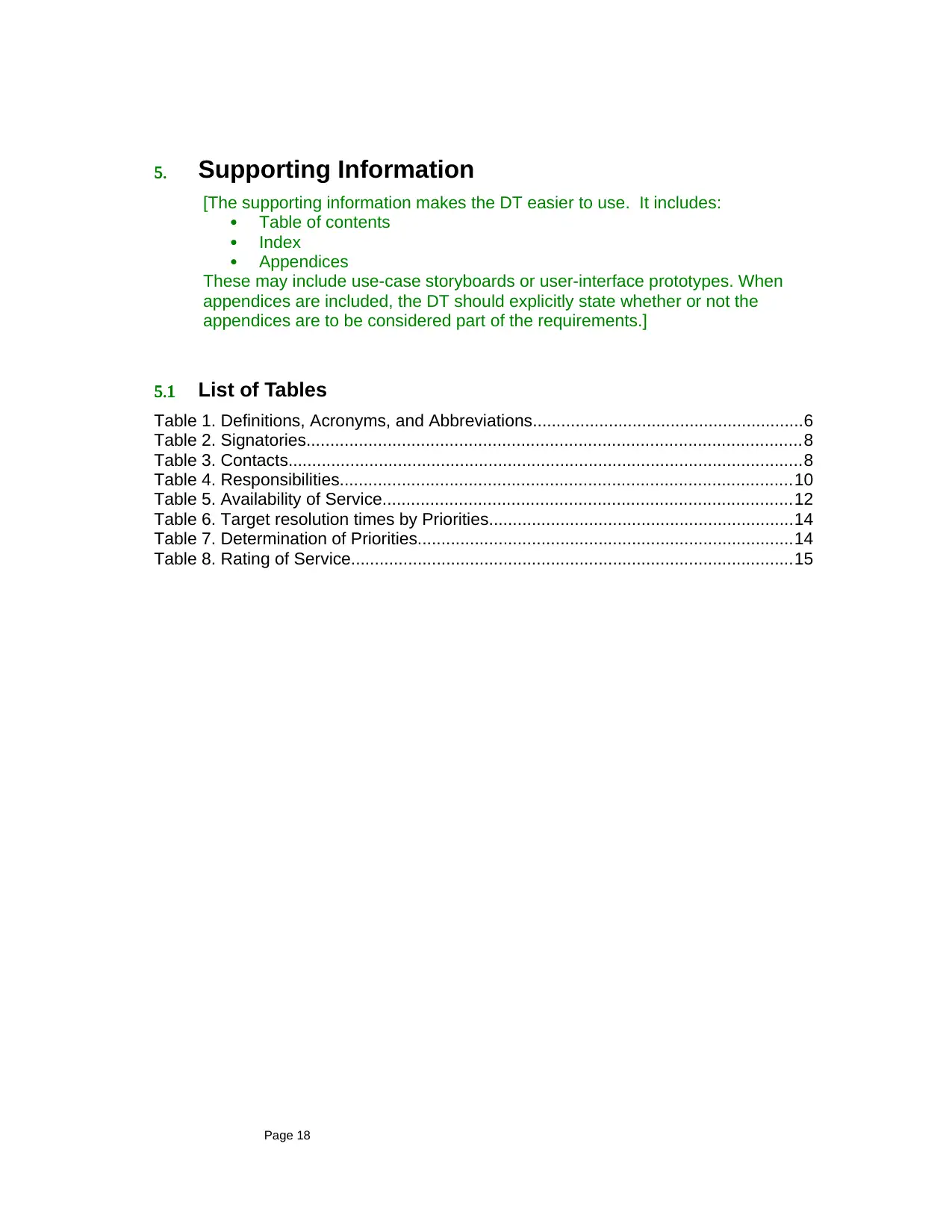
5. Supporting Information
[The supporting information makes the DT easier to use. It includes:
Table of contents
Index
Appendices
These may include use-case storyboards or user-interface prototypes. When
appendices are included, the DT should explicitly state whether or not the
appendices are to be considered part of the requirements.]
5.1 List of Tables
Table 1. Definitions, Acronyms, and Abbreviations.........................................................6
Table 2. Signatories........................................................................................................8
Table 3. Contacts............................................................................................................8
Table 4. Responsibilities...............................................................................................10
Table 5. Availability of Service......................................................................................12
Table 6. Target resolution times by Priorities................................................................14
Table 7. Determination of Priorities...............................................................................14
Table 8. Rating of Service.............................................................................................15
Page 18
[The supporting information makes the DT easier to use. It includes:
Table of contents
Index
Appendices
These may include use-case storyboards or user-interface prototypes. When
appendices are included, the DT should explicitly state whether or not the
appendices are to be considered part of the requirements.]
5.1 List of Tables
Table 1. Definitions, Acronyms, and Abbreviations.........................................................6
Table 2. Signatories........................................................................................................8
Table 3. Contacts............................................................................................................8
Table 4. Responsibilities...............................................................................................10
Table 5. Availability of Service......................................................................................12
Table 6. Target resolution times by Priorities................................................................14
Table 7. Determination of Priorities...............................................................................14
Table 8. Rating of Service.............................................................................................15
Page 18
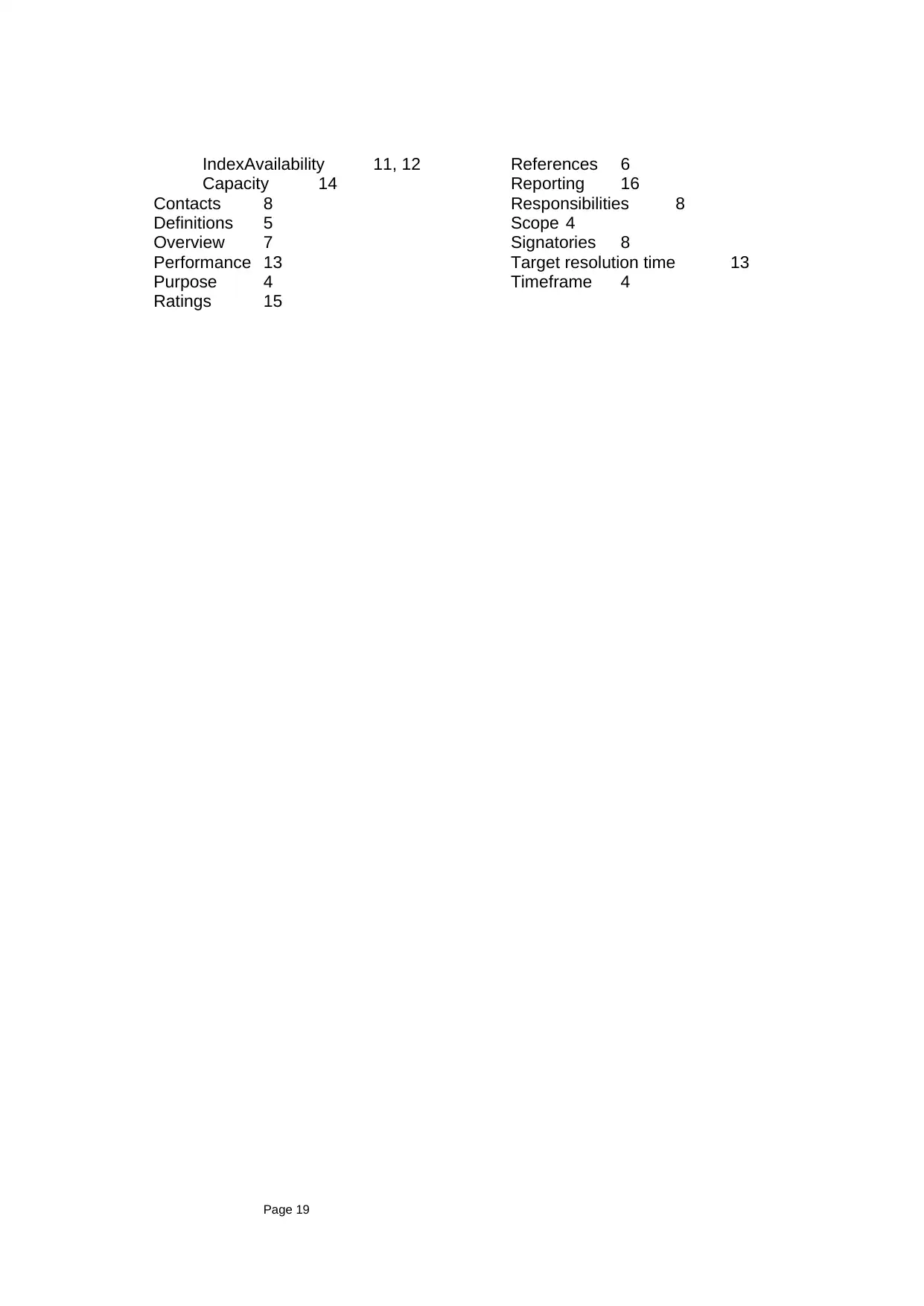
IndexAvailability 11, 12
Capacity 14
Contacts 8
Definitions 5
Overview 7
Performance 13
Purpose 4
Ratings 15
References 6
Reporting 16
Responsibilities 8
Scope 4
Signatories 8
Target resolution time 13
Timeframe 4
Page 19
Capacity 14
Contacts 8
Definitions 5
Overview 7
Performance 13
Purpose 4
Ratings 15
References 6
Reporting 16
Responsibilities 8
Scope 4
Signatories 8
Target resolution time 13
Timeframe 4
Page 19
Paraphrase This Document
Need a fresh take? Get an instant paraphrase of this document with our AI Paraphraser
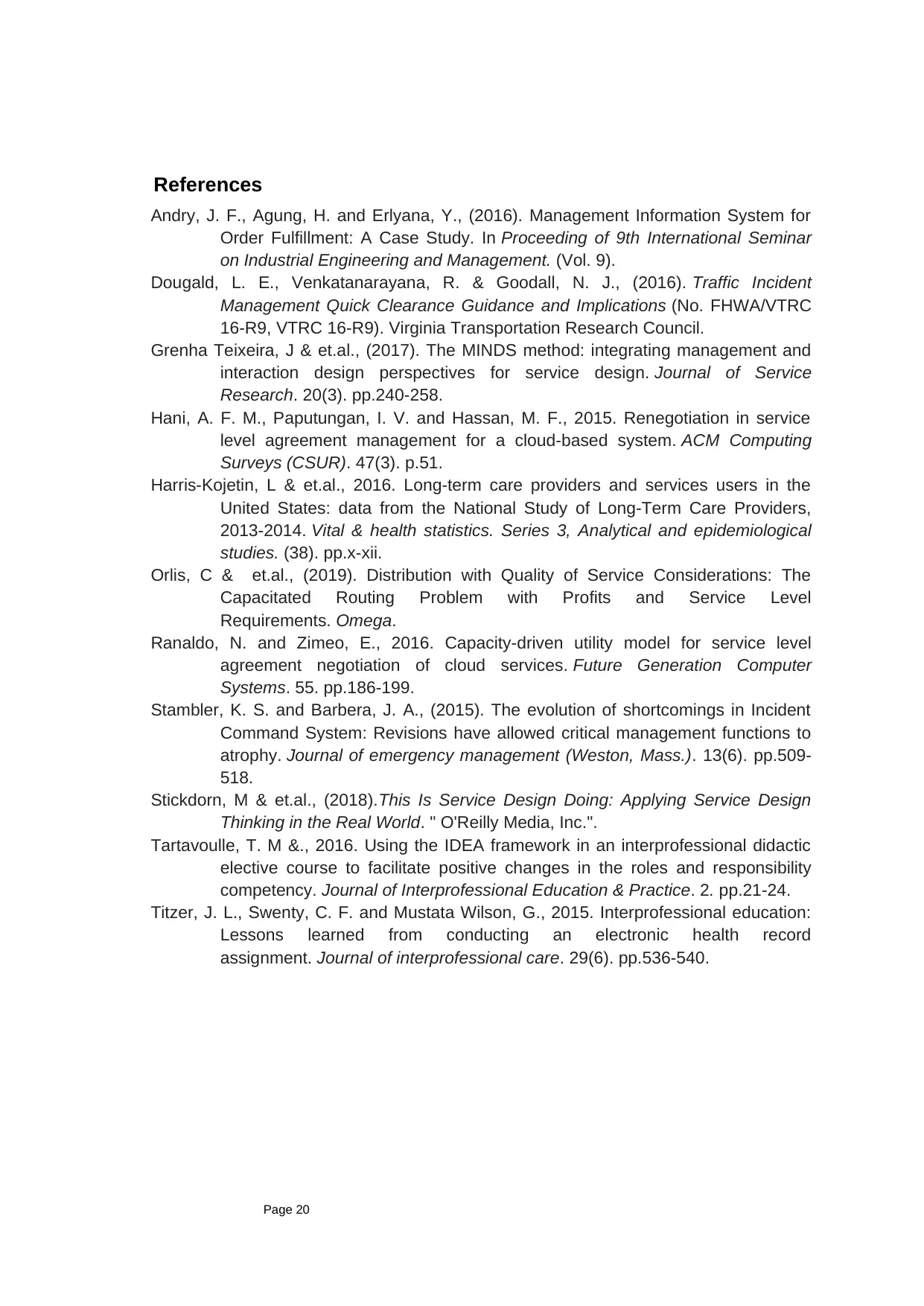
References
Andry, J. F., Agung, H. and Erlyana, Y., (2016). Management Information System for
Order Fulfillment: A Case Study. In Proceeding of 9th International Seminar
on Industrial Engineering and Management. (Vol. 9).
Dougald, L. E., Venkatanarayana, R. & Goodall, N. J., (2016). Traffic Incident
Management Quick Clearance Guidance and Implications (No. FHWA/VTRC
16-R9, VTRC 16-R9). Virginia Transportation Research Council.
Grenha Teixeira, J & et.al., (2017). The MINDS method: integrating management and
interaction design perspectives for service design. Journal of Service
Research. 20(3). pp.240-258.
Hani, A. F. M., Paputungan, I. V. and Hassan, M. F., 2015. Renegotiation in service
level agreement management for a cloud-based system. ACM Computing
Surveys (CSUR). 47(3). p.51.
Harris-Kojetin, L & et.al., 2016. Long-term care providers and services users in the
United States: data from the National Study of Long-Term Care Providers,
2013-2014. Vital & health statistics. Series 3, Analytical and epidemiological
studies. (38). pp.x-xii.
Orlis, C & et.al., (2019). Distribution with Quality of Service Considerations: The
Capacitated Routing Problem with Profits and Service Level
Requirements. Omega.
Ranaldo, N. and Zimeo, E., 2016. Capacity-driven utility model for service level
agreement negotiation of cloud services. Future Generation Computer
Systems. 55. pp.186-199.
Stambler, K. S. and Barbera, J. A., (2015). The evolution of shortcomings in Incident
Command System: Revisions have allowed critical management functions to
atrophy. Journal of emergency management (Weston, Mass.). 13(6). pp.509-
518.
Stickdorn, M & et.al., (2018).This Is Service Design Doing: Applying Service Design
Thinking in the Real World. " O'Reilly Media, Inc.".
Tartavoulle, T. M &., 2016. Using the IDEA framework in an interprofessional didactic
elective course to facilitate positive changes in the roles and responsibility
competency. Journal of Interprofessional Education & Practice. 2. pp.21-24.
Titzer, J. L., Swenty, C. F. and Mustata Wilson, G., 2015. Interprofessional education:
Lessons learned from conducting an electronic health record
assignment. Journal of interprofessional care. 29(6). pp.536-540.
Page 20
Andry, J. F., Agung, H. and Erlyana, Y., (2016). Management Information System for
Order Fulfillment: A Case Study. In Proceeding of 9th International Seminar
on Industrial Engineering and Management. (Vol. 9).
Dougald, L. E., Venkatanarayana, R. & Goodall, N. J., (2016). Traffic Incident
Management Quick Clearance Guidance and Implications (No. FHWA/VTRC
16-R9, VTRC 16-R9). Virginia Transportation Research Council.
Grenha Teixeira, J & et.al., (2017). The MINDS method: integrating management and
interaction design perspectives for service design. Journal of Service
Research. 20(3). pp.240-258.
Hani, A. F. M., Paputungan, I. V. and Hassan, M. F., 2015. Renegotiation in service
level agreement management for a cloud-based system. ACM Computing
Surveys (CSUR). 47(3). p.51.
Harris-Kojetin, L & et.al., 2016. Long-term care providers and services users in the
United States: data from the National Study of Long-Term Care Providers,
2013-2014. Vital & health statistics. Series 3, Analytical and epidemiological
studies. (38). pp.x-xii.
Orlis, C & et.al., (2019). Distribution with Quality of Service Considerations: The
Capacitated Routing Problem with Profits and Service Level
Requirements. Omega.
Ranaldo, N. and Zimeo, E., 2016. Capacity-driven utility model for service level
agreement negotiation of cloud services. Future Generation Computer
Systems. 55. pp.186-199.
Stambler, K. S. and Barbera, J. A., (2015). The evolution of shortcomings in Incident
Command System: Revisions have allowed critical management functions to
atrophy. Journal of emergency management (Weston, Mass.). 13(6). pp.509-
518.
Stickdorn, M & et.al., (2018).This Is Service Design Doing: Applying Service Design
Thinking in the Real World. " O'Reilly Media, Inc.".
Tartavoulle, T. M &., 2016. Using the IDEA framework in an interprofessional didactic
elective course to facilitate positive changes in the roles and responsibility
competency. Journal of Interprofessional Education & Practice. 2. pp.21-24.
Titzer, J. L., Swenty, C. F. and Mustata Wilson, G., 2015. Interprofessional education:
Lessons learned from conducting an electronic health record
assignment. Journal of interprofessional care. 29(6). pp.536-540.
Page 20

Page 21
1 out of 21
Related Documents
Your All-in-One AI-Powered Toolkit for Academic Success.
+13062052269
info@desklib.com
Available 24*7 on WhatsApp / Email
![[object Object]](/_next/static/media/star-bottom.7253800d.svg)
Unlock your academic potential
© 2024 | Zucol Services PVT LTD | All rights reserved.





